Motorola Solutions 89FT7031 Voice Over WLAN Phone with Bluetooth User Manual 9h UMTS ASIAEMEA UG 030607 ofer tab
Motorola Solutions, Inc. Voice Over WLAN Phone with Bluetooth 9h UMTS ASIAEMEA UG 030607 ofer tab
Contents
- 1. Exhibit 8 Users Manual
- 2. Exhibit 8A Supplemental Users Manual
- 3. Exhibit 8a Users Manual
Exhibit 8 Users Manual

about this guide
This guide introduces you to the operation and features of your new handset. It’s divided into ten
main sections:
Throughout this guide, you will find tips that highlight special shortcuts and timely reminders to
help you make the most of your new phone and service. The Table of Contents and Index also
help you quickly locate specific information. You will get the most out of your handset if you read
each section. To get right to a specific feature, simply locate that section in the Table of Contents
and go directly to that page. Follow the instructions in that section and you will swiftly be ready to
use your handset.
•
Section 1: “essentials”
•
Section 2: “tips & tricks”
•
Section 3: “basics”
•
Section 4: “customize”
•
Section 5: “managing calls”
•
Section 6: “e-mail & messages”
•
Section 7: “connections”
•
Section 8: “entertainment”
•
Section 9: “other features”
•
Section 10: “troubleshooting”

1
basic handset features
Technology promised to make your work environment easier... but then it gave you more to
do—phone calls, e-mails, schedules, messaging, managing of documents, the Internet, and more
features.
It’s time to take back control.
It is time to meet the Normandy Handset.
Your handset includes: Smartphone with
voice recognition
for hands-free dialing,
Walkie-talkie
call
button for dispatch and private calls (including private talkgroups), Two way
SMS
and
Instant
Text Messaging
,
Email
,
Contacts
,
Calendar
,
Tasks
etc. - including
viewing mail attachments
and many other built-in tools to help you manage your busy work style.
Normandy also includes access to your
enterprise applications,
standard mobile
internet
browser,
and the ability to pair with
Bluetooth headsets
and other Bluetooth devices such as
personal computers.
The Normandy handset is available in two models; the ruggedized and the office models. Both
modelss have identical functional and operation features and differ slightly by shape. The handset
is designed to work only within the wireless network coverage of your enterprise environment.
This manual covers the basic and advanced operations of your handset. Inclusive understanding
of your Windows applications can be fully achieved by referring to Microsoft® Windows® Mobile
6.1 documentation and on-screen help.
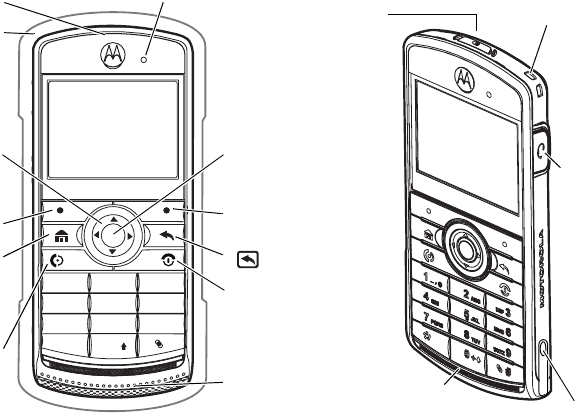
2
Introducing your new wireless LAN
Normandy
handset
! Here is a quick anatomy lesson.
12
3
456
789
0
*
#
_,@
GHI
PQRS
+
TUV
JKL
ABC DEF
MNO
WXYZ
X
Home key
Hold to open a
quick list of
options
(
S
)
Navigation
key
Navigate menus
a
Speaker key
Press & hold for Voice
Recognition or switch to
speakerphone during a call.
Left soft key Right soft key
Call/Answer key
Make & answer
calls
s
Center key
Select highlighted items
O
Power/End key
Turn on & off, hang up,
exit menus.
Back key
Microphone
Speakerphone
&
Audio/PT
T
Jack
Lanyard attach point
Charger contac
t
(ruggedized handset only
)
Display light sensor
Ear piece
P
rotective rubber
suit
(ruggedized
handset only)
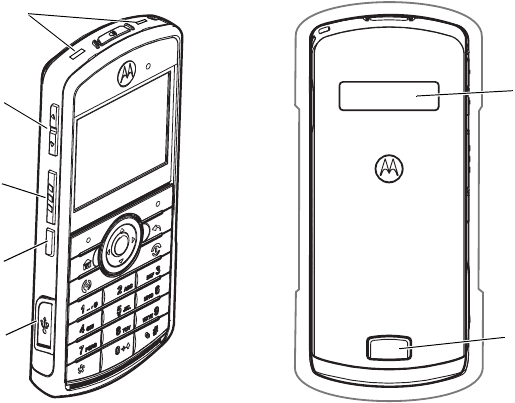
3
To avoid damaging your handset, carry it in an approved holster or case rather than a pocket,
purse, or bag.
Volume
up/down keys
(See page 33)
PTT walkie-talkie
button
(See page 22)
Programmable key
(See page 79)
ID label
window
Battery door
release
(See page 16)
R
Mini USB port
Charge battery &
connect handset to
accessories
Holster latches
(ruggedized handset only)
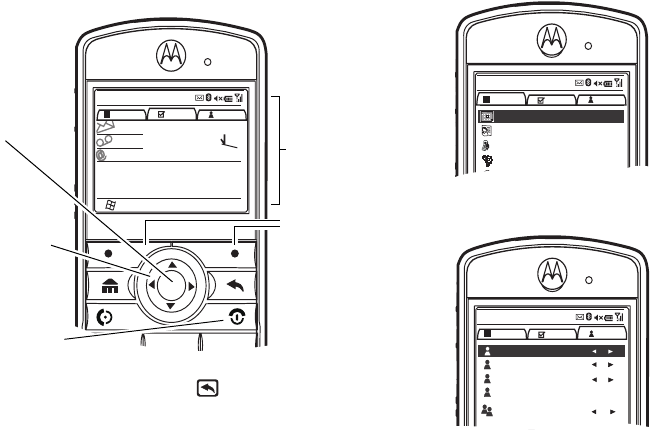
4
From the Home screen, select the Status, Programs or Callers screen.
12
3
456
789
0
*#
_,@
GHI
PQRS
+
TUV
JKL
ABC DEF
MNO
WXYZ
Programs Callers
3
2
14
Profile: Silent
Tomorrow: Jack design review
1:00 - 3:30PM (Park Av 2002)
Start Contacts
Status
Phone: on 11:00 pm
Thu 27
12
3
456
789
0
*#
_,@
GHI
PQRS
+
TUV
JKL
ABC DEF
MNO
WXYZ
Programs Callers
Status
1 Calendar
2 Contacts
3 Call History
4 Settings
5 Messaging
Hptt
Programs Callers
Status
Adam Smith
Alexandra Brown
(057) 184-9622
Marketing Group
Macy Sall
HHW
hHh
h
5
.
Press the left /right
soft keys to open the
screen menus. The
menu label of the soft
key is displayed at the
bottom of the screen.
1
. Press and hold the
Power key
O
to turn
on your headset.
2
.
Press the
Navigation key - up,
down, left, or right
(
S
) to highlight a
menu feature.
3
.
Press the Center
key
s
to select the
highlighted feature.
Tip:
Press the Back key to go back one menu. Press the Power
key
O
to exit any menu or view without saving changes. At any time,
press the Home key
X
to return to the Home screen.
Home Screen
Programs Screen
4
.
Use the Navigation
key (
S
) to explore
today’s status screen,
your recently used
programs and the
incoming calls history.
Callers Screen
5
If you need help while using your handset, see
the Motorola Support Web site at
www.TBD.com
.
Motorola, Inc.
Consumer Advocacy Office
1307 East Algonquin Road
Schaumburg, IL 60196
Certain handset features are dependent on the capabilities and
settings of your organization network. Additionally, certain
features may not be activated by your organization, and/or the
organization's network settings may limit the feature’s
functionality. Always contact your network management about
feature availability and functionality. All features, functionality,
and other product specifications, as well as the information
contained in this user's guide are based upon the latest available
information and are believed to be accurate at the time of printing.
Motorola reserves the right to change or modify any information or
specifications without notice or obligation.
MOTOROLA and the Stylized M Logo are registered in the US
Patent & Trademark Office. All other product or service names are
the property of their respective owners. The Bluetooth trademarks
are owned by their proprietor and used by Motorola, Inc. under
license. Java and all other Java-based marks are trademarks or
registered trademarks of Sun Microsystems, Inc. in the U.S. and
other countries. Microsoft, Windows and Windows Me are
registered trademarks of Microsoft Corporation; and Windows XP
is a trademark of Microsoft Corporation.
© Motorola, Inc., 2007.
Caution:
Changes or modifications made in the radio phone, not
expressly approved by Motorola, will void the user’s authority to
operate the equipment.
Software Copyright Notice
The Motorola products described in this manual may include
copyrighted Motorola and third-party software stored in
semiconductor memories or other media. Laws in the United
States and other countries preserve for Motorola and third-party
software providers certain exclusive rights for copyrighted
software, such as the exclusive rights to distribute or reproduce
the copyrighted software. Accordingly, any copyrighted software
contained in the Motorola products may not be modified,
reverse-engineered, distributed, or reproduced in any manner to
the extent allowed by law. Furthermore, the purchase of the
Motorola products shall not be deemed to grant either directly or
by implication, estoppel, or otherwise, any license under the
copyrights, patents, or patent applications of Motorola or any
third-party software provider, except for the normal, non-exclusive,
royalty-free license to use that arises by operation of law in the
sale of a product. Manual Number:

6
approved accessories
approved accessories
Stay fully mobile while you
work, walk and talk.
Get Motorola approved
accessories for your
handset.
Phone Tools Software
TBD
Batteries
•
1400mAh battery
•
1700mAh battery
Chargers
•
Multi-unit charger
(for ruggedized handsets)
•
Single-unit desktop charger
(for non-ruggedized handset)
•
Travel Charger EMU Mid-Rate
Switcher
•
Travel Charger EMU Rapid
Switcher
Wire Headset
•
Breeze headset with Boom mic
•
Earbud with clip & PTT
(Surveillance) (AJ)
•
Earpiece with mic & PTT (AJ)
•
Earpiece with mic
•
Earpiece with boom mic & PTT
(AJ))
Wireless Headsets
•
Bluetooth® Headset (Aphrodite) -
H700
Phone Cases
•
Functional carry case
•
Non-functional case
•
Plastic Holster
Memory Card
•
1G MicroSD
•
2G MicroSD
Cables
•
Mini USB data cable
•
Charger Adapter EMU/EMU
(Y-cable)
General
•
Extra battery door
•
Phone tray
•
Safety coil cord
T
o order accessories outside of your
organization, log on to our Web site at:
www.motorola.com/store/ide
or contact a Motorola Authorized
Retailer.

contents
7
contents
essentials 17
battery 17
battery installation 17
battery removal 18
battery charging 18
conserve battery life 19
battery tips 20
Storage card 21
turn haedset on & off 22
username and
passwords 22
make a phone call 22
answer a call 23
make a private call
(walkie-talkie) 23
answer a private call 24
request PTT call (call
alert) 24
send request PTT call 24
receive request PTT
call 25
store a phone number 25
call a stored number 26
view your handset
number 26
tips & tricks 27
basics 28
display 28
find a menu feature 29
status indicators 30
text entry 32
volume control 34
speakerphone controls
35
lock & unlock handset 36
customize 38
profiles 38
sound 39
download a sound file 39
deleting ring tones 40
time & date 40
phone 40
auto answer 40
call barring 41
call forwarding 41
call options 41
call waiting 41
caller ID 41
channels 42
8
contents
DTMF 42
fixed dialing 42
my numbers 42
manage in-call
notifications 42
display 44
change background
image 44
backlight 45
answer options 45
third-party applications
46
task manager 46
managing calls 47
turn off a call alert 47
recent calls 47
redial 48
view missed calls 49
caller ID 49
emergency calls 49
external calls 50
speed dial 50
access speed dial
entries 50
set speed dial numbers
50
set menu shortcuts to
speed dial 51
delete a shortcut. 51
voicemail 51
three-way calling 52
conference call 52
PTT group call 53
answer a PTT group
call 53
join an active PTT
group 53
transfer a call 54
in-call notifications 55
e-mail & messages
56
receive & read
messages 56
message attachments
56
message options 57
send a message 58
global address look up 59
messaging quick
reference 60
instant messaging 65
connections 67
PTT & stereo headsets
67
Bluetooth™ wireless 67
turn Bluetooth power
on or off 67
pair with a headset or
contents
9
handsfree device 68
send objects to another
device 69
use your handset as a
PC remote 69
advanced
Bluetooth features 70
synchronize 71
sync over the air 72
sync with a computer
72
installing & setting up
ActiveSync 72
sync with
Bluetooth™ connectio
n 74
web browser 76
entertainment 77
picture options 77
play video clip 77
video options 78
play a video clip 78
video playback options
79
other features 80
quick access key 80
programmable key 80
advanced calling 80
call forwarding 80
voice dial 81
call a phone number in
a message 81
contacts 81
search for contact 81
edit contact 82
set ringer ID for a
contact 82
set picture ID for
contact 82
send contact to
another device 83
personalizing 83
language 83
accessibility 84
ring volume 84
master reset 86
call times 86
network connections 87
calendar 88
calculator 89
internet security 90
handset information 90
handset administration
data 91
fun & games 92
troubleshooting 94
service & repair 95
index 105
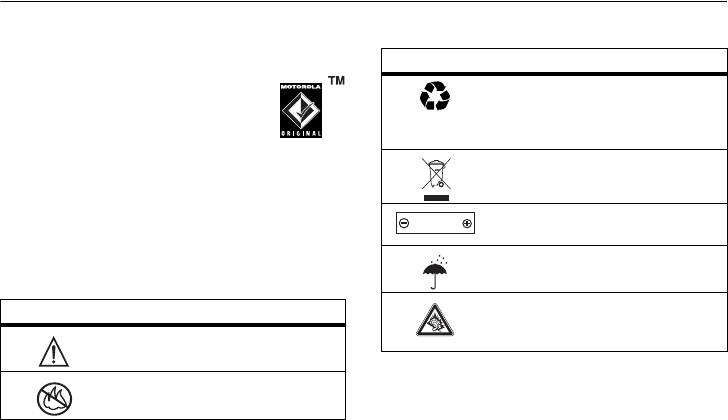
10
Safety Information
Safety and General Information
Safety I nformati on
Batteries and Chargers
If jewelry, keys, beaded chains, or other conductive
materials touch exposed battery terminals, this
could complete an electrical circuit (short circuit),
become very hot, and could cause damage or
injury. Be careful when handling a charged battery,
particularly when placing it inside a pocket, purse, or other
container with metal objects.
Use only Motorola Original
batteries and chargers.
Caution:
To avoid risk of personal injury, do not dispose of your
battery in a fire.
Your battery, charger, or handset may contain symbols, defined as
follows:
Symbol Definition
Important safety information follows.
Do not dispose of your battery or handset
in a fire.
032374o
032376o
Your battery or handset may require
recycling in accordance with local laws.
Contact your local regulatory authorities
for more information.
Do not throw your battery or handset in
the trash.
Your handset contains an internal lithium
ion battery.
Do not let your battery, charger, or mobile
device get wet.
Listening at full volume to music or voice
through a headset may damage your
hearing.
Symbol Definition
032375o
032378o
Li Ion BATT

Safety Information
11
Choking Hazards
Your handset or its accessories may include detachable parts,
which may present a choking hazard to small children. Keep your
handset and its accessories away from small children.
Glass Parts
Some parts of your handset may be made of glass. This glass could
break if the product is dropped on a hard surface or receives a
substantial impact. If glass breaks, do not touch or attempt to
remove. Stop using your handset until the glass is replaced by a
qualified service center.
Seizures/Blackouts
Some people may be susceptible to epileptic seizures or blackouts
when exposed to flashing lights, such as when playing video
games. These may occur even if a person has never had a previous
seizure or blackout.
If you have experienced seizures or blackouts, or if you have a
family history of such occurrences, please consult with your
physician before playing video games or enabling a flashing-lights
feature (if available) on your handset.
Discontinue use and consult a physician if any of the following
symptoms occur: convulsion, eye or muscle twitching, loss of
awareness, involuntary movements, or disorientation. It is always
a good idea to hold the screen away from your eyes, leave the
lights on in the room, take a 15-minute break every hour, and stop
use if you are very tired.
Caution About High Volume Usage
Listening at full volume to music or voice through a
headset may damage your hearing.
Repetitive Motion
When you repetitively perform actions such as pressing keys or
entering finger-written characters, you may experience occasional
discomfort in your hands, arms, shoulders, neck, or other parts of
your body. If you continue to have discomfort during or after such
use, stop use and see a physician.
Product Safety and RF Exposure
Before using this handset, read the product safety
and RF exposure leaflet, Motorola publication
Number 6802983C16 included with this handset.
The leaflet contains important operating
instructions for safe usage and RF energy
awareness and control information for compliance with RF energy
exposure limits in applicable national and international standards.
032374o
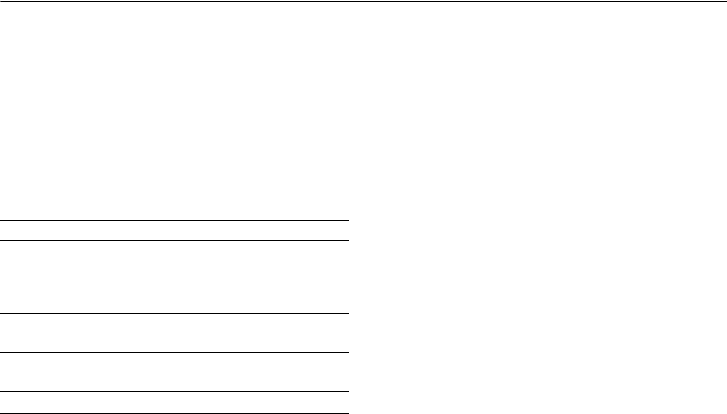
12
FCC Notice
grant of equipment authorization
FCC Notice
IMPORTANT:
Unauthorized repairs or modifications could result
in permanent damage to the equipment and void your warranty
and your authority to operate this device under Part 15 of the FCC
Rules.
FCC Grant of Equipment Authorization
FCC ID: AZ489FT7031
Industry Canada Grant of Equipment Authorization
ID: 109U-89FT7031
This Class B digital apparatus complies with Canadian ICES-003
FCC INTERFERENCE
NOTE:
This equipment has been tested and found to comply with
the limits for a Class B digital device, pursuant to Part 15 of the
FCC Rules. These limits are designed to provide reasonable
protection against harmful interference in a residential
installation. This equipment generates, uses and can radiate radio
frequency energy and, if not installed and used in accordance with
the instructions, may cause harmful interference to radio
communications. However, there is no guarantee that interference
will not occur in a particular installation. If this equipment does
cause harmful interference to radio or television reception, which
can be determined by turning the equipment off and on, the user is
encouraged to try to correct the interference by one or more of the
following measures:
•
Reorient or relocate the receiving antenna.
•
Increase the separation between the equipment and
receiver.
•
Connect the equipment into an outlet on a circuit different
from that to which the receiver is connected.
•
Consult the dealer or an experienced radio/TV technician
for help.
Radio Network Freq Band Rated Power
802.11a WLAN 5.15-5.25 GHz
5.25-5.35 GHz
5.47-5.725 GHz
5.725-5.825 GHz
15.8mW at
54Mbps
802.11b WLAN 2412-2462MHz 63mW at
11Mbps,
802.11g WLAN 2412-2462MHz 17.8mW at 54
Mbps
Bluetooth WPAN 2402-2480MHz 1mW
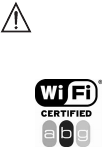
FCC Notice
13
This device complies with Part 15 of the FCC Rules. Operation is
subject to the following two conditions:
(1) This device may not cause harmful interference.
(2) This device must accept any interference received, including
interference that may cause undesired operation.
IMPORTANT:
In the band 5150-5250 MHz the device may only be
used indoors, to reduce potential for harmful interference to
co-channel mobile satellite systems.
Changes or modifications made in the handset, not
expressly approved by Motorola, will void the user's
authority to operate the equipment.
Wi-Fi Certification
This product is a certified: IEEE 802.11a, IEEE 802.11b and IEEE
802.11g, IEEE 802.11e, WPA, WPA2, TKIP, WMM, X.509.
032374o
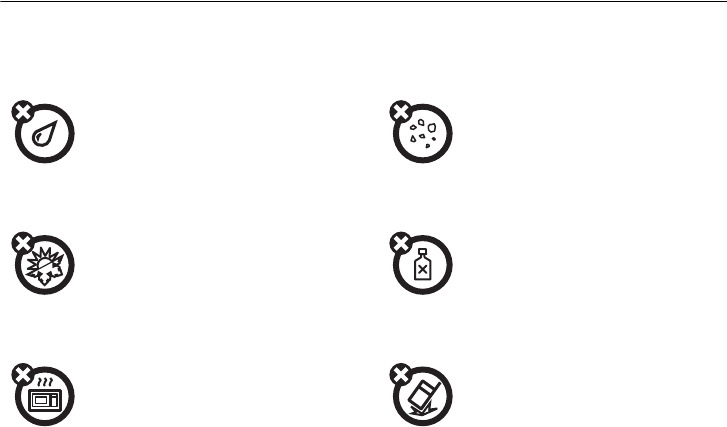
14
use and care
use and care
use and care
To care for your handset, please keep it away from the following:
liquids of any kind dust and dirt
Do not expose your handset to water, rain,
extreme humidity, sweat, or other moisture.
Do not expose your handset to dust, dirt, sand,
food, or other inappropriate materials.
extreme heat or cold cleaning solutions
Avoid temperatures below 0°C/32°F or
above 45°C/113°F.
To clean your handset, use only a dry soft
cloth. Do not use alcohol or other cleaning
solutions.
microwaves the ground
Do not try to dry your handset in a microwave
oven.
Do not drop your handset.

cycling Information
15
cycling Information
caring for the environment by recycling
This symbol on a Motorola product means the product
should not be disposed of with household waste.
disposal of your handset and accessories
Please do not dispose of handsets or electrical accessories, such
as chargers or headsets, with your household waste. In some
countries or regions, collection systems have been set up to handle
waste electrical and electronic items. Please contact your regional
authorities for more details. If no suitable scheme exists, you may
return unwanted handsets and electrical accessories to any
Motorola Approved Service Centre in your region.
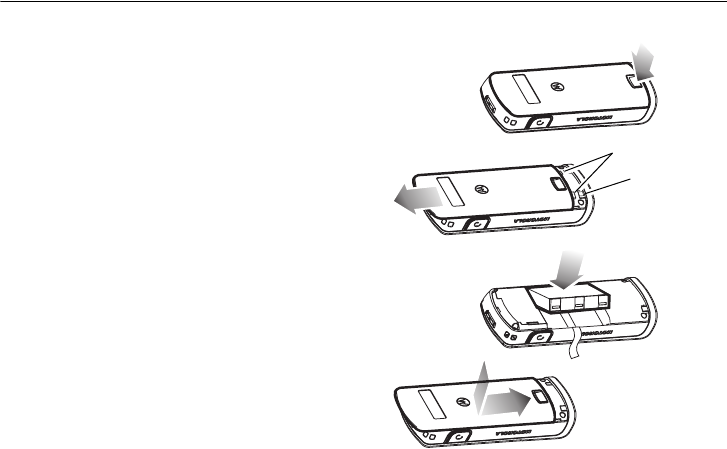
16
essentials
essentials
battery
battery installation
1
Press the battery door release.
2
Slide and remove the battery door.
Note:
Use this opportunity to place the ID label of your
handset inside the window of the battery door.
3
Insert the battery into the battery compartment and
press down to secure it.
Note:
Make sure that the battery removal strip is routed
under the battery.
4
Place back the battery door and slide it so that the
tabs on the battery door insert into the slots on the
handset.
1
2
3
4
Slots
Tabs
Battery removal strip
(ruggedized handset on
ly)
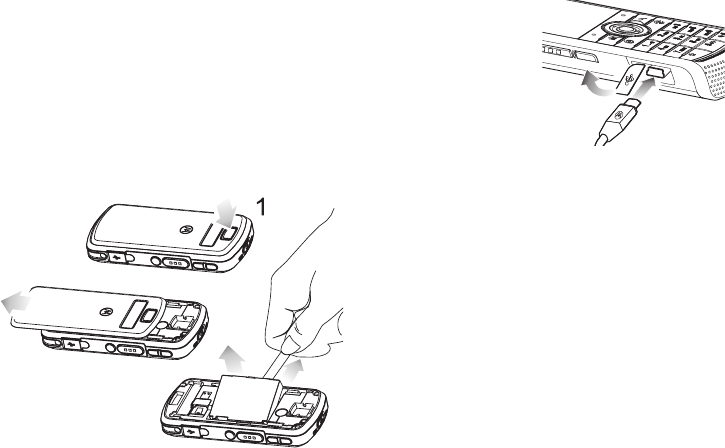
17
essentials
battery removal
1
With the handset powered off, press the battery
door release.
2
Slide and remove the battery door.
3
Remove the battery from the battery compartment
by lifting it out from the side. When using the
ruggedized handset, pull the battery removal strip
to lift out the battery.
battery charging
New batteries are
not fully charged.
Plug the Rapid
Travel Charger into
your handset and
an electrical outlet,
your display shows
the charging indicator
O
. Your handset might
take several seconds to start charging the
battery. When finished, your display shows a
full battery icon
J
.
Tip:
You can not overcharge your battery. It will perform
best after you fully charge and discharge it a few times.
You can also charge your battery with a
USB
cable
plugged into a computer, unless your
battery is completely drained.
Tip:
Use the Rapid Travel Charger or desktop charger
for completely drained batteries.
2
3
Battery removal strip
(ruggedized handset only)
cycling Information
18
Install the software from your Companion CD
onto your PC before you try to charge your
handset through USB port. Plug the cable into
a powered USB hub or port, since some USB
devices (such as keyboards) might not supply
enough power for charging.
Note:
Charging the handset with a USB cable may
require more time than the using the Rapid Travel
Charger.
Important:
When using a USB cable to charge or work
with the handset, make sure you are using 3.6V, 950mA
approved cable.
conserve battery life
Modifying the handset backlight conserves
the battery life.
To set how long your handset waits before the
backlight
turns off, perform the following:
1
Press:
Start
>
Settings
>
Power Management
>
Backlight time
out on battery
or
Backlight time out on
AC
. When the backlight is off, the display is visible
but dim.
2
Close unused programs, from the home screen,
press:
Start
>
System Tools
>
Task
Manager
. Select the program and press:
Menu
>
Kill
.

19
essentials
battery tips
Battery life depends on the network, signal
strength, temperature, features, and
accessories you use.
Warning:
Before handling
batteries, please note the following:
•
Always use Motorola Original
batteries and chargers. The warranty does not
cover damage caused by non-Motorola
batteries and/or chargers.
•
New batteries or batteries stored for a long time
may take more time to charge.
•
When charging your battery, keep it near room
temperature.
•
When storing your battery, keep it uncharged in
a cool, dark, dry place.
•
Never expose batteries to temperatures below
0°C (32°F) or above 45°C (113°F).
•
It is normal for batteries to gradually wear down
and require longer charging times. If you notice
a change in your battery life, it is probably time
to purchase a new battery.
Contact your organization or local
recycling center for proper battery
disposal.
Warning:
Never dispose of batteries in a fire
because they may explode.
Before using your handset, read the battery
safety information in the “safety and general
information” section included in this guide.
032375o
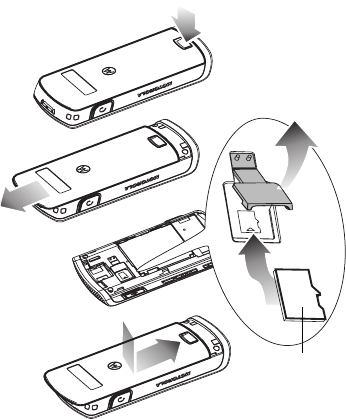
20
essentials
Storage card
Your handset allows you to use an optional
microSD storage card to expand the available
memory space. This secure digital card stores
your mail attachments, images, music,
voicemail, text messages, etc. You can
transfer files from your handset or microSD
storage card to your PC by using a USB cable
or over Bluetooth communication.
To install a microSD storage card:
1
With the handset powered off, press the battery
door release.
2
Slide and remove the battery door.
3
Pull out the rubber latch (A) and insert the microSD
storage card (B) into the card compartment.
4
Place back the battery door and slide it so that the
tabs on the battery door insert into the slots on the
handset.
Caution:
Do not bend or scratch your memory card.
Keep it away from static electricity, water, and dirt.
1
2
4
3
A
B
B
microSD
storage
card

21
essentials
turn haedset on & off
1 To turn on your handset,
perform the following:
Press and release
O
. If
prompted, enter your
four-digit unlock code.
Tip:
If your handset does not turn
on, remove the battery and put it
back in, and try again.
2 To turn off your handset
,
perform the following
:
Press and hold
O
for 3 seconds, then
release
it.
You can also press and hold
X
to open the quick
options menu, then select
Power off
.
username and passwords
When turning on your handset for the first
time, you may need to set your username and
password to access the network. Ask your
operator for assistance.
make a phone call
To place a phone call from
the home screen, enter a
phone number and press
N
to make a call.
To place a phone call from
your Contacts list:
1
Press the
right soft key
to
open the
Contacts
menu.
2
Press the navigation key
S
to scroll to
a
number
.
3
Press
N
to call.
To place a phone call from company directory
1
Press the
right soft key
to open the
Contacts
menu.
2
Press
Menu
and use the navigation key
S
to
scroll to
Company Directory
.
23
56
89
0#
+
TUV
JKL
ABC DEF
MNO
WXYZ
12
45
78
0
*
_,@
GHI
PQRS
+
TUV
JKL
ABC
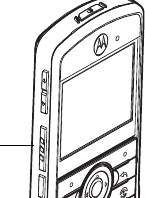
22
essentials
3
Press the navigation key
S
to scroll to
a
number
.
4
Press
N
to call.
answer a call
When your handset rings and/or vibrates,
press
N
to answer. To “hang up,” press
O
.
•
When you are busy when a call comes in, select
Ignore
to send the call directly to voicemail.
•
To put a call on hold, press
N
. To return to the
call, press
N
again.
If you are on a call and another call comes in
you may select one of the following:
•
When you are busy when a call comes in, select
Ignore
to send the new call directly to
voicemail.
•
To put a call on hold, press
N
to answer it and
put the current call on hold (press
N
to switch
between the two calls).
make a private call (walkie-talkie)
With private call, you use your handset as a
long-range, walkie-talkie.
1
Enter the Private ID
you want to call or
select the number
as you would when
making a phone
call.
2
Press and hold the
PTT button on the
left side of your
handset.
3
Begin talking after your handset emits a chirping
sound.
4
Release the PTT button to listen.
To place a private call from you contacts list:
P
TT
b
utton
23
essentials
1
Press the
rightsoftkey
to open the
Contacts
menu.
2
Press the navigation key
S
to scroll to
a
number
.
3
Press and hold the PTT button on the left side of
your handset.
4
Begin talking after your handset emits a chirping
sound.
5
Release the PTT button to listen.
Note:
Your private call automatically ends if not
responded within a few seconds.
answer a private call
When you receive a Private call, your handset
emits a chirping sound or vibrates.
1
Wait for the caller to finish speaking.
2
Press and hold the PTT button on the side of your
handset.
3
Begin talking after your handset emits a chirping
sound.
4
Release the PTT button to listen.
request PTT call (call alert)
Send a request PTT call to let the recipient
know you want to talk on a private call. When
you send call alert, the recipient’s phone emits
a series of beeps, or vibrates and displays
your name or Private ID.
The recipient can select one of the following
options:
•
Answer - begin a Private call with you
•
Answer later - access the call alert later from the
Start menu or from the a list of incoming calls on
Call History
•
Dismiss - clear and delete the call alert
24
essentials
send request PTT call
1
Enter the Private ID you want to call or select the
number as you would when making a phone call.
2
Select
Menu > Request PTT Call
. The PTT
Alert Sent appears on the display.
Note:
When the alert is not successful, this means that
the person you are trying to reach is on a call or has the
handset turned off.
receive request PTT call
When you receive a call alert, you can either
answer, ignore, or clear the call.
•
Answer a call alert by pressing the PTT button
to receive a Private call from the sender.
•
Clear a call alert by selecting:
Menu >
Dismiss
.
Note:
Call History list also stores call alerts you have
received. They appear as Missed PTT Call alerts remain
in your Call History list until you delete them or until they
reach the end of the list.
store a phone number
You can store a number for future calls by
saving it to Contacts.
Find it:
Press:
Start
>
Contacts
and press
New.
1
Choose whether the contact will be stored on your
Outlook contact or your handset.
2
Enter information for the contact.
Note:
While you are entering the number,
you can program your handset to pause
and then dial more digits (such as a
voicemail password or PIN).
Program your handset to pause and then
dial more digits by doing one of the
following:
•
Press:
Menu
>
Insert Pause
to insert a
2-second pause (shows as a
p
)
25
essentials
•
Press:
Menu
>
Insert Wait
to instruct your
handset to prompt before dialing the remaining
digits (shows as a
w
).
Insert Wait
does not
work for contacts stored on your handset.
Tip:
When you get a call or message from someone
who is not in your list of contacts, you can create a
contact from
Call History
, or from the message by
pressing
Menu
>
Save to Contacts
.
call a stored number
Find it:
Press:
Start
>
Contacts
1
Scroll to the number.
2
Press
N
.
Your handset calls the contact’s default
number.
Tip:
When you stored more than one number for a
contact, select the contact to see the other numbers. To
dial a number, scroll to it and press
N
.
view your handset number
You can view your handset number.
Find it:
Press:
Start
>
Settings
>
Phone
>
Call Options
.
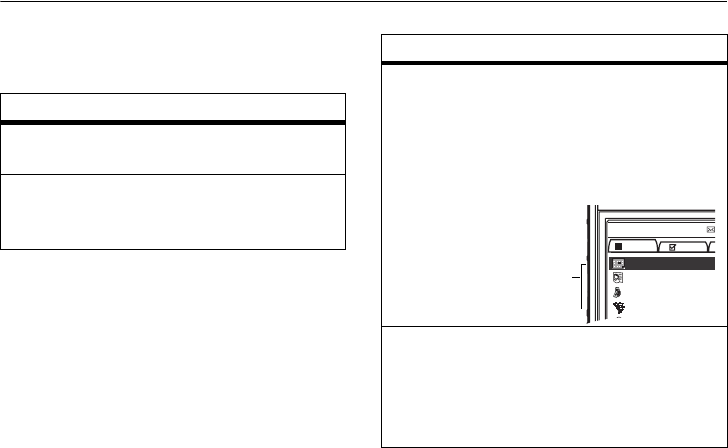
26
tips & tricks
tips & tricks
From the home screen
(shown on page 25),
you can use the following shortcuts:
To... Do this...
Increase
screen font TBD
lock handset Press and hold
X
to open
the quick options menu,
then select
Lock
.
open
recently
used
program
Icons from your most
recently used features
appear in Programs tab of
the home screen. Use the
up/down navigation key to
scroll and select a program.
Select profile Press and hold
X
to open
the quick options menu,
then scroll to select
Normal,
Silent, Vibrate, Outdoor,
or Automatic
.
To... Do this...
Programs Status
1 Calendar
2 Contacts
3 Call History
4 Settings
5 Messaging
Recently
used
features
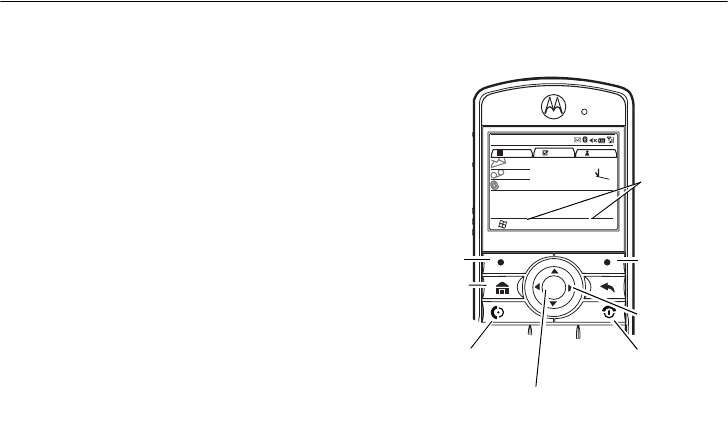
27
basics
basics
display
The home screen appears when you turn on
the handset. To dial a number from the home
screen, press the number keys and
Call/Answer key
N
.
For a basic handset diagram, See page 1.
Note:
Your home screen can look different than this one.
The on-screen Soft key labels show the
current soft key functions.
Press the left and right soft keys to open the
current available menu and for selecting
options.
Press the navigation key
S
up, down, left, or
right to scroll to a menu item or text and press
the center key
s
to select.
Press
X
to return to the home screen.
12
3
456
789
0
*
#
_,@
GHI
PQRS
+
TUV
JKL
ABC DEF
MNO
WXYZ
Programs Callers
3
2
14
Profile: Silent
Tomorrow: Jack design review
1:00 - 3:30PM (Park Av 2002)
Start Contacts
Status
Phone: on 11:00 pm
Thu 27
Left soft key Right soft key
On-screen
Soft key labe
ls
Navigation ke
y
Center key
Call/Answer key
N
Power/End key
N
H
ome key
X
Left soft key
28
basics
find a menu feature
To navigate to a menu feature on you
handset, look for the “Find it” instruction. The
following example instruct you how to look for
a received call:
Find it:
Press:
Start
>
Call History
>(received call)
This “Find it” means that, from the home
screen perform the following steps:
1
Press the
left soft key
to open the
Start
menu.
2
Press the navigation key
S
to scroll to
#Call History
.
3
Press the center key
s
to select
Call History
.
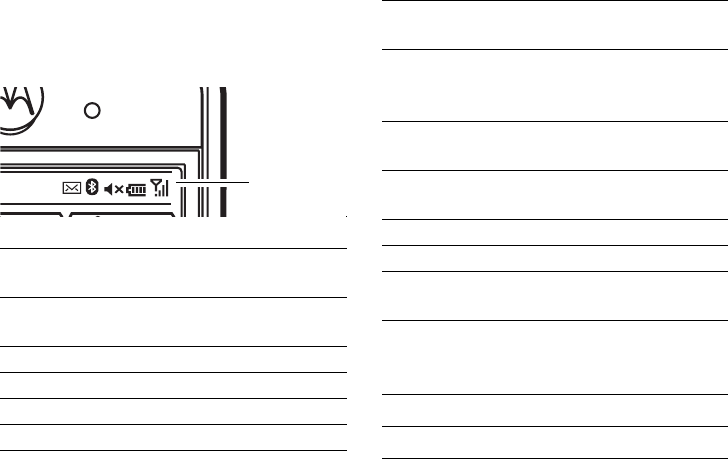
29
basics
status indicators
Status indicators appear at the top of the
home screen..
E
Missed Call Indicator – Shows when
you have missed a call.
TBD
Connecting to wireless network
(in-process)
TBD
Connected to wireless network.
TBD
PTT call - in call.
TBD
Talkgroup - in call.
TBD
Phone call - in call.
Status indicato
rs
S
Phone call(s) on hold - one or more
phone calls are on hold.
%
Speakerphone
profile indicator - Shows
speakerphone is turned on during a
phone call.
Q
Silent
profile indicator - Shows when your ring
profile
is set to silent.
<
Vibrate p
rofile indicator - Shows when
your
ring
profile
is set to vibrate.
TBD
PTT speaker is on.
TBD
PTT speaker is off.
B
Voicemail Indicator - Shows when you
have new voicemail.
C
Message Indicator - Shows
when you have new email or text
message.
Z
Instant messenger is on.
g
ActiveSync error.
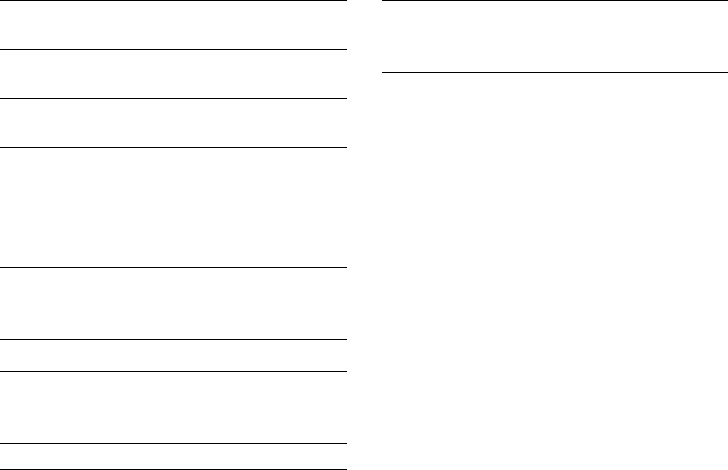
30
basics
ISV
Independent software vendor
application is currently running.
E
Bluetooth® Indicator - Shows when
Bluetooth power is on.
D
Call Forward Indicator – Shows when
call forwarding is on.
J
Battery Level Indicator - Shows the
battery charge level by using the
vertical bars.
Note:
Recharge the battery when your phone
shows one or two bars.
O
Charging Indicator - Shows when a
charger is connected to the handset
and charging.
P
Battery removed.
0
Signal Strength Indicator - Shows the
strength of the network connection by
using the vertical bars.
6
Wireless radio status
2
No connection to wireless network. You
can’t make or receive calls when no
vertical bars appear.
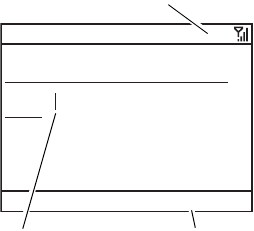
31
basics
text entry
You can enter text into your handset using the
traditional method of pressing a key several
times for each character.
You can also press a key once for each letter
while words likely to be the one you want are
chosen from a database.
You can also enter symbols and numbers into
a text field.
When you select a field that requires text or
numbers, the handset automatically selects
the appropriate entry mode. An indicator at
the top right of the display shows the entry
mode you are currently using (See the
following figure).
Send
Text Messages
0/160
Menu
To: Dan Brown
abc
Hi Dan,
Entry modes indicator. For mode
descriptions, see the following table.
Flashing cursor indicates
insertion point. for typing a
character.
After 2 seconds, character is
accepted & cursor moves to
next position.
Press Menu to see more
options.
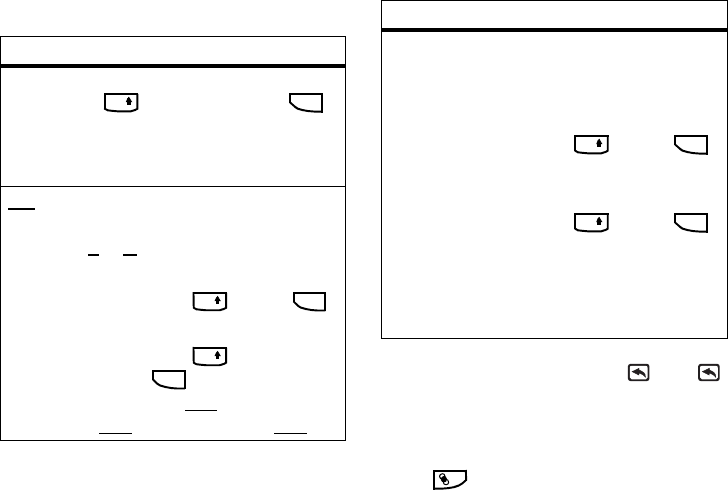
32
basics
•
To
delete
one character, press . Hold
to keep deleting.
•
To start a new line, press
s
.
•
To enter a symbol (such as
!
), press and hold
and select a symbol or special character.
entry modes
abc
Letters mode (default) - press and
hold
and keep pressing
to switch between all capital letters
(
á
)
,
no capitals (
Á
), or next
letter capital (
Â
).
abc
Underline mode enters the
underline letters
on each key (such
as
q
or
Q
). For underline mode,
perform the following:
1
Press and hold
and then
for 2 seconds and release.
2
Press and hold
and swiftly keep
pressing to switch between all
capital letters (
á
), no capitals
(
Á
), or next letter capital (
Â
).
0+
*
0+
*
0+
*
123
Only numbers mode - Enters the
number on each key (such as
5
).
For only numbers mode perform the
following:
1
Press and hold
and then
for 2 seconds and release (the screen
switches to underline mode).
2
Press and hold
and then
for 2 seconds and release.
Note:
Your handset automatically chooses
123
numbers when number entries are
required - like phone numbers.
entry modes
0+
*
0+
*
#
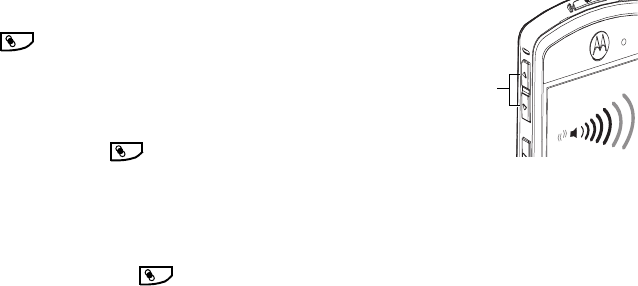
33
basics
When done, the handset returns to the previous
text entry mode.
•
To enter a space after your characters, swiftly
press .
As you enter letters, your handset might try to
predict
the word. For instance, it might predict
“program” when you enter “prog”.
To enable prediction, hold
,
select
Setup
and use
S
and check
Word completion
. To
turn off text prediction, press:
Start
>
Settings
>
Text Input Settings
and uncheck
Text
Prediction
.
To change the language, hold
,
select
Setup
and use
S
to select
Language
Dictionary
, or select
Clear Contents to
clear
the memory of the words you’ve used.
volume control
Note:
When you are
not
on a call perform
the following:
1
Press the
Volume up/down
keys to adjust
the ringer
volume level - the display shows seven ringer
levels
.
2
Continue pressing the volume key for: Beep ring ->
Silent mode -> Vibrate mode -> Lock current ring
level -> Unlock current ring level.
When you are on a phone call, press volume
up/down keys to adjust the earpiece volume.
Tip:
Need to change profiles on the fly?
On the home screen, scroll to and select
Profile
. Choose from
Normal
,
Silent
,
Vibrate
and others.
#
#
#
Volume
up/down
keys
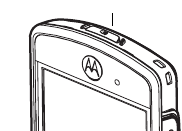
34
basics
Want to turn off a sound? Press:
Start
>
Settings
>
Sounds
. Highlight the
desired item and select the sound you
want to associate with that item.
You can eliminate the ringer volume
instantly when an incoming call comes
in-just press the Volume up or Volume
down keys to turn the ringer off.
speakerphone controls
Turning on speakerphone makes incoming
sound come out of the phone’s speaker
instead of the earpiece. Speakerphone is
available whenever you are on an active
phone call.
Warning:
The speakerphone generates high
volume levels. do not place the handset near
your ear when using the speakerphone.
Activate the speakerphone during a call by
pressing:
Menu > Speakerphone
.
You can also
activate the
speakerphone
during a call by
pressing the
Speaker key.
During a call, press
speaker key
a
to turn on the speakerphone
or press the left soft key. A
%
at the top of
your display indicates the speaker is on. In
private mode, the screen displays the PTT
speaker state. To turn it off, press speaker key
a
again or end the call.
Note:
Speakerphone is not available when your handset
is connected to a headset. When using a
Bluetooth™ headset, disconnect the headset by
pressing:
Menu
>
Handsfree Off
and then
Menu
> Speakerphone.
Speaker key
a
35
basics
lock & unlock handset
You can manually lock your handset to
prevent accidental keypresses.
To
lock your handset
, press and hold
X
until the
Quick List
opens. Then, select
Lock
. Your left soft key becomes
Unlock
.
To
unlock your handset
, press
Unlock
and
enter your password. Your handset uses
*
if
you have not set a password.
To
keep others from using your handset
,
change your password:
Find it:
From the home screen, press:
Start
>
Settings
>
Security
>
Device Lock
1
Check the
Prompt if device unused for
checkbox, and select the amount of time for the
handset to be inactive before automatically locking.
2
Choose a password type that is either simple
(4-digit number) or strong alphanumeric
Note:
A hard-to-guess password with at
least 7 characters, including uppercase
and lowercase letters, numerals, and
punctuation).
3
Enter and confirm your password.
4
Press
Done
.
To unlock the handset, press
Unlock
. When
you see the unlock prompt, enter your
password and press
Done
.
Tip: Choose a password you will remember
. Without
your password, you can reset your handset, but it will
result in the loss of your personalized settings and all
content stored in handset memory. To perform a hard
reset, hold down the center key
s
for 5 seconds while
turning the handset on.
Note:
You can make emergency calls on a locked
handset (See page 48). A locked handset still rings or
36
basics
vibrates for incoming calls or messages, but you do not
need to unlock it to answer.

37
customize
customize
profiles
Each profile uses a different set of sounds,
ring styles, earpiece volume settings, or
vibrations for incoming calls and other events.
For example, the
Outdoor
profile volume is
much louder than the
Normal
profile.
Here are the profiles you can choose:
Indicators can appear at the top of your home
screen for the
Silent
(
Q
) and
Vibrate
(
<
)
profiles. A
%
means that the speakerphone is
on (see page TBD).
Note:
The
Automatic
profile is the same as
Normal
, except that it automatically switches to
Vibrate
during any event stored in your Calendar.
To choose your profile:
Find it:
On the home screen, scroll and select
Profile:
>profile style name
Normal Vibrate Automatic
Silent Outdoor
38
customize
sound
You can change the ring tones for incoming
calls and other events.
Find it:
Press:
Start
>
Settings
>
Sounds
1
Scroll and highlight the sound you want to change,
then press the navigation key
S
right or left to
change it. To play the sound, press: Menu > Play.
2
Press
Done
to save the sound setting.
Note:
Here are the sounds you can
change:
Ring tone, Reminders, New e-mail, New
text message, New voice message, New
instant message, Alarm clock, PTT Call
Request, Incoming PTT, Exclamation,
Question, Warning, Keypad control,
Note:
Changes made to the alert settings will have no
effect when using the
Silent
profile.
download a sound file
When you download a sound file for a ring
tone, it does not automatically save in the
Sounds location. To move your sound file
perform the following:
Find it:
Start
>
File Manager
>
My
Documents
.
1
Highlight the sound file you want to copy to the
Sound location
2
Press:
Menu
>
File
>
Copy to
and select
Application Data
>
Sounds
.
Note:
If the sound file is not located in the
My Documents folder, go to the folder
where the sound file is stored and copy it
to the Sounds folder.
39
customize
deleting ring tones
When you delete a custom ring tone from your
handset, you will have to download it again.
To delete a custom ring tone, perform the
following:
1
Scroll and highlight the sound you want to delete,
then press the navigation key
S
right or left to
delete.
2
Press
Menu > Delete Sounds
.
time & date
Your operator usually sets the time and date
on your handset. To change it manually:
Find it:
Press:
Start
>
Settings
>
Clock &
Alarm
>
Date and Time
1
In
Time Zone
, use the navigation key
S
to
select your time zone.
Note:
Update your time zone when you
travel, to make sure your handset’s
calendar events appear at the right time.
2
In
Date
, edit the month, day, or year.
3
In
Time
, edit the hour, minute, and second.
4
Press
Done
to save the time and date settings.
You can specify the time and date style by
changing the regional settings. Press:
Start
>
Settings
>
Regional Settings
.
phone
auto answer
Find it:
Press:
Start
>
Settings
>
Phone
>
Auto
answer.
40
customize
Auto-answer allows your incoming calls to be
answered automatically without a press of a
key. This feature is useful when using a
hands-free device such as a headset. This
setting does not work when your handset is in
silent mode.
call barring
Find it:
Press: Start > Settings > Phone > Call Barring.
Enables you to restrict or bar certain or all
types of calls to and from your handset, such
as incoming, outgoing and outgoing
international (Int’l) calls. This option requires a
personal code.
Note:
Although calls are barred, calls may still be made
to your emergency numbers.
call forwarding
Find it:
Press: Start > Settings > Phone > Call
Forwarding.
Call forwarding sends your calls to voicemail
or a custom phone number you specify. You
can set your handset to forward missed calls
when your handset does not reply, busy,
unavailable or always upon an incoming call
(unconditionally).
call options
Find it:
Press: Start > Settings > Phone > Call options.
TBD
call waiting
Find it:
Press: Start > Settings > Phone > Call Waiting.
Call waiting is an audible signal that indicates
an incoming call during your phone call.
caller ID
Find it:
Press: Start > Settings > Phone > Caller ID.
41
customize
This option displays your phone number or
name on the called party screen during the
ringing signal. Your number or name may also
show on the called party during the call or
loged as an incoming call when your call is not
answered.
channels
Find it:
Press: Start > Settings > Phone > Channels.
TBD
DTMF
Find it:
Press: Start > Settings > Phone > DTMF.
Dual-tone multi-frequency (DTMF) is used for
tone dialing and signaling telephone
networks.
Normally the duration of DTMF tones should
be set to Long. Some networks and
applications use Short tones.
fixed dialing
Find it:
Press: Start > Settings > Phone > Fixed Dialing.
A service feature allows you to restrict your
outgoing calls and messages to selected
phone numbers. The selected phone numbers
are included in the fixed dialing list.
my numbers
Find it:
Press: Start > Settings > Phone > My Numbers.
TBD.
manage in-call notifications
When you receive a message during a phone
or PTT call, your handset notifies you with
pop-up text on the display and a notification
tone or vibration. You can access the
message or dismiss the notification.
42
customize
When you dismiss the notification, the
message is not deleted. Notification can be
accessed through the main screen.
To set notifications,
Find it:
Press:
Start
>
Settings
>
Phone >
In-call Notifications
Use the checkboxes to select the event of
notification while you are on a phone or PTT
call.
Note:
Use the navigation key
S
to select a common
sound level to all notifications.
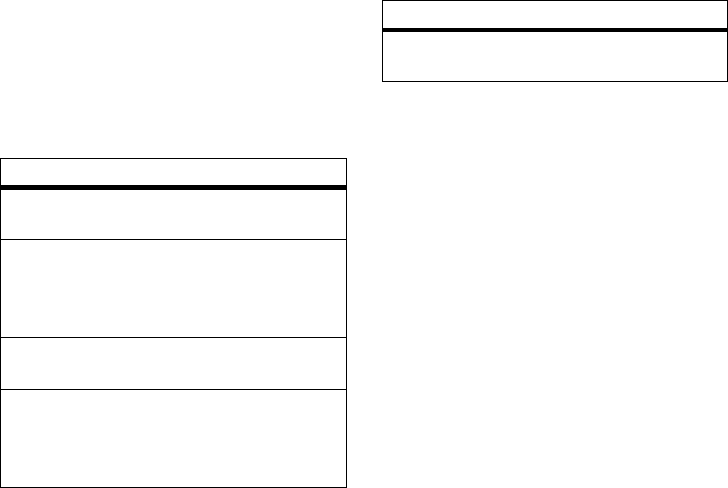
43
customize
display
Set a photo or picture as a wallpaper
(background) image or change your layout
and color scheme on your home screen.
Find it:
Press:
Start
>
Settings
>
Display
change background image
Want to copy an image from your PC to your
handset to use as a background image?
Note:
Your PC must have
Microsoft® Windows® Mobile Device Center (on a PC
running Windows Vista) or you must install
Microsoft ActiveSync on your PC as described on page
78.
1
Connect the handset to your PC.
2
On your PC, copy the image file you want. The file
format must be: .gif, .jpg, or .bmp.
3
In ActiveSync on your PC, select Explore and
double-click My Windows® Mobile device.
options
Home screen
layout
Select a layout for the
home screen.
Home screen
image
Select a picture for your
wallpaper image, or
Default
for default
wallpaper.
Color
scheme
Select a color scheme for
the display.
Time out
Select the time interval
before the display returns
to the home screen, or
Never
.
System font
size
Change the font size for
better readability
options
44
customize
4
Double click My Documents, then double click
My Pictures and paste the image into that folder.
When you download a picture file for a
wallpaper, it might not automatically save in
the
My Pictures
folder. To move your picture
file perform the following:
1
Press:
Start
>
File Manager
>
My Documents
.
2
Highlight the picture file you want to copy to the My
Pictures location, press:
Menu
>
File
>
Copy to
and press:
My Documents
>
My Pictures
.
Note:
If the picture file is not located in
the
My Documents
folder, go to the
folder where the picture file is stored and
copy it to the
My Pictures
folder.
backlight
Your handset automatically adjusts the display
brightness when you move between bright
and dark environments. To save battery life,
your display backlight turns off when you’re
not using your handset. The backlight turns
back on when you press a key. To set how
long your handset waits before the backlight
turns off:
Find it:
Press:
Start
>
Settings
>
Power Management
>
Backlight time out
on battery
or
Backlight time out on AC.
answer options
Use answer options to set
any key
to answer
an incoming call.
Find it:
Press:
Start
>
Settings
>
Phone
>
Call Options
>
Any key answer
.
45
customize
third-party applications
Third-party applications, or add-on programs,
can include e-mail, security, mobile office, and
productivity software. These products can
typically be downloaded and installed
immediately. Compatible commercial and free
applications are available on the Internet. For
more information, see the downloads catalog
on the Motorola Support Web site at:
www.hellomoto.com
, or see your operator.
Note:
Applications written for previously released
devices or older versions of Windows Mobile may not
function reliably on this handset. Contact the application
provider to check compatibility before installing the
application on this handset.
task manager
To see what programs are running (active) on
your handset or stop a specific program from
running, use the Task Manager.
Find it:
On the home screen, press:
Start
>
System
Tools
>
Task Manager
Tip:
Need to stop running a program? In
Task
Manager
, select the program and press:
Menu
>
Kill
.
You can completely remove a program from
your handset.
Find it:
Press:
Start
>
Settings
>
Remove
Programs
.
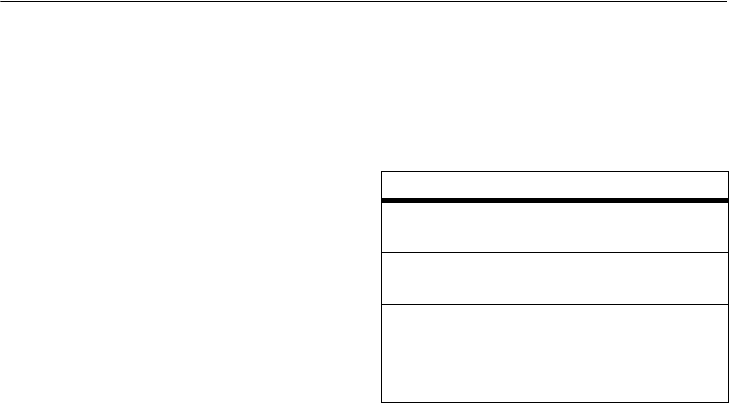
46
managing calls
managing calls
To make and answer calls, see page 21.
turn off a call alert
You can use the up/down volume keys to turn
off the ringer before answering the call.
recent calls
Your handset keeps a list of incoming and
outgoing calls, even for calls that did not
connect. The most recent calls are listed first.
The oldest calls are deleted as new calls are
added.
Find it:
Press:
Start
>
Call History
Highlight a call, then:
•
To call the number, press
N
.
•
To see call details (like time and date), press the
center key
s
.
•
To see
Menu Options
, select
Menu
from
the
Call History
view. This menu include the
following options:
options
Request PTT
Call PTT call to this phone
number.
Send Text
Message
Send a text message to
this phone number.
E-mail
Send an e-mail message
to this contact (if you
already have the
contact’s e-mail address).
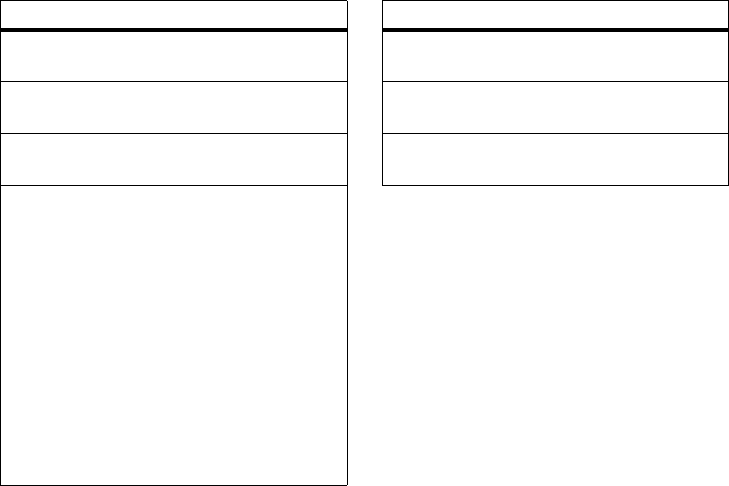
47
managing calls
redial
1
Press
N
from the home screen to see the calls
and contact list.
2
Highlight the entry you want to call, then press
N
or press the PTT button for a private call.
When you hear a busy signal and you see
Call Failed, Number Busy
, press
N
to
redial the number. When the call goes
through, your handset rings or vibrates once,
View Timers
View the call times for this
call.
Delete
Delete this call from the
Call History.
Delete List
Delete all calls from the
Call History.
View By Filter all calls in the Call
History list.
You can filter your calls
by: By Caller, By Timer,
Missed Only, Incoming
Only, Outgoing, PTT
Only.
For example, When you
filter the list for all Missed
Calls, it will only show the
incoming phone calls that
you did not answer.
options
Save to
Contacts
Save this number to a
contact.
Send MMS
Send a multimedia
message to this number.
Find Contact
Find this phone number
in your
Contacts
.
options
48
managing calls
shows
Redial Successful
, and connects the
call.
view missed calls
Your handset keeps a record of your
unanswered calls.
1
Press:
Start
>
Call History
.
2
Press:
Menu
>
View By
>
Missed Only
.
caller ID
Calling line identification (caller ID) shows the
name or phone number of the caller for an
incoming call on your home screen.
Your handset shows the caller’s name and
picture when they are stored in your contacts
or
Incoming Only
when caller ID information
is not available.
You can set your handset to play a distinctive
ringer ID for specific entries stored in your
contacts(See page 80).
emergency calls
Your operator programs one or more
emergency phone numbers, such as 911 or
112. You can call emergency under any
circumstances even when your handset and
keypad are locked.
1
Press the keypad keys to dial the emergency
number.
2
Press
N
to call the emergency number.
Note:
Emergency numbers vary by country. Your
handset’s pre programmed emergency number(s) may
not work in all locations, and sometimes an emergency
call cannot be placed due to network, environmental, or
interference issues.
49
managing calls
external calls
If your handset service includes external
dialing to enable you to call out of your
organization.
1
Press and hold
0
to insert your local external
access extension (indicated by
+
).
2
Press the keypad keys to dial the phone number.
speed dial
You can use speed dialing in two ways: quick
access for up to 98 phone numbers and
shortcuts to features found in the Start menu
including e-mail, calendar, and
Bluetooth™ Manager.
access speed dial entries
To access speed dial entries, press and hold
the single-digit speed dial number for one
second. If the speed dial is two digits, press
the first digit, then press and hold the second
digit. The handset dials the phone number,
opens a new e-mail message, or goes to the
Web page.
set speed dial numbers
You can set the speed dial to call the entries in
your handset’s contact list:
1
Press:
Start
>
Contacts
.
2
Scroll to the desired contact and press the
center key
s
.
3
Select the phone number or e-mail address for
which to create the speed dial.
4
Press:
Menu
>
Add to Speed Dial.
5
In the
Keypad Assignment
, select the speed
dial number.
Note:
Speed dial 1 is reserved for calling
your voicemail.
50
managing calls
6
Press
O
.
You can delete
a speed dial entry.
Find it:
Press:
Start
>
Speed dial
, scroll to the entry,
then press:
Menu
>
Delete
.
set menu shortcuts to speed dial
You can set a shortcut to open an application
on your handset:
1
Press the
Programs tab
.
2
Scroll to the icon of the application you want a
shortcut for and press:
Menu
>
Add Speed Dial
.
3
In the
Keypad Assignment
, select the
shortcut number.
4
Press
O
.
delete a shortcut.
Find it:
Press:
Start
>
Speed Dial
, scroll to the
shortcut, then press: >
Menu
>
Delete
.
Note:
Your organization may add a
Voicemail
shortcut you cannot delete.
voicemail
Your network stores the voicemail messages
you receive.
When you
receive
a voicemail message, your
handset shows the voicemail message
indicator
B
.
To
check
voicemail messages:
Press and hold
1
.
Note:
You can not store a pause (
p
) or wait (
w
)
character in your voicemail number. When you want to
store a voicemail number with these characters, create
a contact for your voicemail number (See page 24) and
51
managing calls
use the contact to call your voicemail. Your organization
may include additional information about using this
feature.
three-way calling
Three-way calling enables you talk to two
people at the same time.
While connected to a call perform the
following:
1
Place your current call on hold by selecting Menu >
Hold.
2
Enter the number of the other person you wish to
connect to a three-way call and press
N
.
3
Once you are connected to the other phone, you
can scroll between the desired contacts and press
N
to switch between the calls (the other call will
be on Hold). You can also press:
Menu
>
Transfer to
combine them.
If you
receive a second call
while you are
already on a call:
1
To answer the second call, scroll to the second call
and press
N
. The first call will switch to hold.
2
Scroll between the desired calls and press
N
to
switch between the calls.
3
Press:
Menu
>
Transfer to
combine the calls.
Note:
To send the second call to your voicemail,
press
Ignore
.
conference call
During an active call, you receive call.
1
Scroll to the incoming call and press the center key
s
.
2
Press the Send key
N
to answer the incoming
call.
52
managing calls
3
Press: Menu > Conference with > “caller name” (or
contact, recent call, phone number) and press the
center key
s
Note:
Conference call may include up to six
people. At any time during the conference call,
press the
center key
s
to see who is on the call.
PTT group call
A PTT group call is similar to a private call, but
is made to all members of a talkgroup at once.
Note:
A talkgroup is a predetermined group in your
organization.
From Contacts
1
Press: Start > Contact > Menu.
2
Scroll to the talkgroup you want to join.
Note:
To dial a group that is not on your list, dial
#
and a number between 1 and 255.
3
Press the PTT key.
Note:
An active PTT group is the group that you are
currently affiliated with. You can only receive and
monitor one Talkgroup at a time - your active PTT
Group.
answer a PTT group call
To answer a PTT group call, proceed as if
answering a Private call (See page 22). Only
one person at a time may speak on a group
call. The Private ID or name of the person
who is speaking will appear on the display
below the group number.
join an active PTT group
To join a PTT group listed on your Contacts
list:
1
Press: Start > Contacts > Menu
2
Select the Talkgroup you want to join.
3
Press: Menu > Join.
53
managing calls
4
Press Done (left soft key).
5
Press the PTT key.
Note:
When you initiate a PTT group call to another PTT
group, that PTT group becomes the active PTT group.
When the PTT group is not on your Contacts
list:
1
Press the Send key
N
to open the Dialer screen.
2
Dial the talkgroup number (dial
#
and a number
between 1 and 255).
3
Press: Menu > Join PTT Group.
4
Select the Talkgroup you want to join.
5
Press: Menu > Join.
6
Press: Done.
7
Press the PTT key.
transfer a call
During an active call:
1
Press: Menu > Transfer to.
2
Scroll to the desired contact and press the
center key
s
.
3
To speak to your contact (or recent call, phone
number) before transferring the call, press Yes. For
direct transfer press No.
4
Press Transfer.
5
Press Done to complete the transfer.

54
managing calls
in-call notifications
During an active call, a new notification
appears as follows:
•
A pop-up notification is displayed at the bottom
of the screen.
•
A notification indicator is displayed at the top of
your screen.
•
A notification tune is played
In-call notifications may include: New
Voicemail(s), New Text Message, New E-mail
message, Missed PTT Call, PTT Call
Request, Ended Phone/ PTT/ Talkgroup calls,
Calendar Reminder.
During an active call, you receive a pop-up
notification of a Text Message:
1
Scroll to the incoming notification and press the
center key
s
.
2
Press the back key or Done.
During an active call, you receive a PTT
notification:
1
Scroll to the incoming notification
2
Press the center key
s
.
3
Press the PTT button to answer (the active call will
be place on hold).
4
Press Resume to resume the call on hold.
Note:
To set the type of notifications you may receive
during a call, press: Menu > In-call Notifications or
during a call, press: Menu > Go To> Notification settings.

55
e-mail & messages
e-mail & messages
To set up e-mail on your handset refer to
your operator at your organization.
receive & read messages
When you receive a message your handset
plays an alert and shows
New Message
with
the message indicator
C
on the home
screen.
Find it:
On the home screen, press:
Start
>
Messaging
>(e-mail account).
If you do not see a list of messages
, press:
Menu
>
Folders
>
Inbox
.
To return to the folder list, press:
Menu
>
Folders
.
To read a message:
Press the
navigation key
S
to scroll to the message
and press the center key
s
to open it.
When you have a message open
, press the
navigation key
S
right to open the next
message, or left to open the previous
message.
message attachments
When an e-mail has Microsoft® Word, Excel,
or PowerPoint files attached, you can open
and edit them using
Documents To Go
. You
can also view .pdf file attachments, or extract
.zip file attachments.
Download the attachment, then select the file
and follow the prompts to open it. When the
56
e-mail & messages
document opens, you can move around the
page using the navigation key
S
.
•
Excel spreadsheets: Select cells and enter
numbers or text. Press Menu for the following
options: save, cut, copy, paste, find, delete, etc.
•
PowerPoint slide shows: Press the left softkey
to switch between notes, outline and slide
views. Press Menu for the following options:
save, cut, copy, paste, find, delete, etc.
•
Word documents: Type numbers or text into the
document. Press Menu for the following options:
save, cut, copy, paste, find, delete, etc.
•
PDF documents: Press the Zoom key to change
the zoom level. Press the Menu key to save a
copy of the file, switch pages or other functions.
To
transfer
attachments to your computer for
editing, use Microsoft® ActiveSync or
Windows® Mobile Device Center.
message options
To delete, save, reply, or forward the
messages, use these quick steps from the
Inbox with a message selected or when
viewing a message:
•
To delete, press
Delete
.
•
To reply, press:
Menu
>
Reply
or
Reply
All
. Enter the message and press
Send
.
•
To forward, press:
Menu
>
Reply
>
Forward
. Enter the message and press
Send
.
•
To create a contact card for the sender, highlight
the sender and press the
center key
s
>
Save
.
Tip:
Need to check your e-mail right now? Press:
Start
>
Messaging
. Select the account to send and receive
messages and press:
Menu
>
Send/Receive
. The
handset connects to your Internet e-mail server and
57
e-mail & messages
sends and receives your messages. To stop this
process, press:
Menu
>
Stop Send/Receive
.
send a message
You can send three types of messages: SMS
(text messages), MMS (multimedia
messages), and email messages.
Find it:
Press:
Start
>
Messaging
>
Text Messages
,
MMS
, or (e-mail account)
To send a message:
1
Press:
Menu
>
New
.
2
For e-mail, in
To
,
Cc
, and/or
Bcc
, enter e-mail
addresses. Insert a semicolon (;) between multiple
numbers or addresses.
For text messages, enter the contact
telephone number.
Tip:
You can quickly enter phone numbers
or e-mail addresses from your contact
cards. In
To
, press
s
and select a
recipient from the list. Then select the
recipient's phone number or e-mail
address.
3
Use the keypad to compose a message.
4
Press
Send
.
Tip:
In an e-mail or MMS message, you
can insert a
picture, voice note or file
in
the message. On the message area,
press:
Menu
>
Insert
>
Picture
or
Voice
Note
or
File
.
Note:
If you select to insert a voice note into the
message, you will also need to record it. Press
Record
and start speaking into the handset's microphone. When
finished speaking, press
Stop
and then
Done
.
To set the priority for an e-mail message,
press:
Menu
>
Message Options
.
To cancel a message, press:
Menu
>
Cancel Message
.
58
e-mail & messages
global address look up
From your handset, you can search the global
address list (GAL) stored on your company's
Exchange Server. This means that you can
find a contact’s phone number or e-mail
without having to store the information directly
to your handset.
Note:
GAL information can only be viewed during a data
transfer session. The entire GAL cannot be stored for
viewing offline.
GAL Lookup can be found from
Contacts
and
Company Directory
.
Company Directory
is
found in
Messaging
,
Phone
,
Calendar
and
Speed Dial
.Here’s how to use GAL to search
for a contact:
1
Press:
Start
>
Contacts
.
2
In the contact list, press:
Menu
>
Company Directory
.
3
Enter search criteria and press
Search
.
4
Scroll through the list of entries that appears. When
you locate your contact, press
N
to make a call.
Note:
Although the entire GAL cannot be
stored on your handset, once the contact
is found, you can add the single contact to
your contact list.
Tip:
You can also choose to send a message, SMS or
e-mail to a contact found using GAL. In a new message
or e-mail, press:
Menu
>
Company Directory
.
When you locate the contact to send a message,
highlight and select it. The e-mail information is
populated into the
To:
field.

59
e-mail & messages
messaging quick reference
Note:
Some features might not work if you set up your
e-mail account manually (without the e-mail setup
wizard).
features
send text message
Press:
Start
>
Messaging
>
Text Messages
, and press
New
create and send e-mail
Press:
Start
>
Messaging
>(e-mail account), and press
New
To add a picture, voice note, or file to an
e-mail message, open the message area
and press:
Menu
>
Insert
>
Picture
,
Voice Note
,or
File
.
Tip:
You can save a draft of a message that you are
composing to finish and send later. Press:
Menu
>
Save to Drafts
. A draft of the message is stored
in the Drafts folder of the account you are in.
features
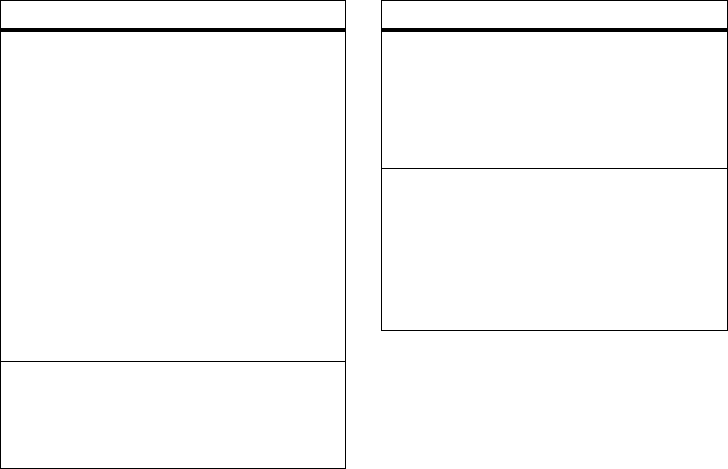
60
e-mail & messages
create and add an e-mail signature
Press:
Start
>
Messaging
>(e-mail account), and press
Menu
>
Tools
>
Options
>
Signatures
Scroll to the account for which you are
creating the signature.
Select
Use signature with this account
.
Select the
Signature
box, enter your
signature, and press
Done
.
Tip:
To insert a signature in every message you send,
select
Include when replying and
forwarding
. Otherwise, a signature is inserted
only in new messages.
read new messages
To quickly view new messages, select the
message notification area on the home
screen.
features
view attachment
While viewing the message, use the
center key
s
to select the attachment.
Note:
You can view attachments only for file types
that are supported by the handset.
read old messages
Press:
Start
>
Messaging
>(e-mail account)
Icons next to each message show if it is
unread
J
,
read
H
,
urgent
K
, or has an
attachment
R
.
features

61
e-mail & messages
reply, reply all or forward messages
From your Inbox or an open message,
press:
Menu
>
Reply
,
Reply All
, or
Forward
Tip:
When you are replying to an e-mail in the e-mail
account, you will send less data if you do not edit the
original message. This may reduce data transfer
costs based on your rate plan.
features
download message objects
When an e-mail message includes an
attachment, open the message and the
name of the attachment will appear
highlighted. To download the attachment,
select the highlighted attachment name.
The attachment is downloaded the next
time you synchronize or connect to your
e-mail server.
Note:
When there are multiple attachments in the
message, only the selected attachments are
downloaded.
insert a media object in an e-mail
To add a picture, voice note, or file in an
e-mail message in the composing message
area press:
Menu
>
Insert
>
Picture
,
Voice Note
or
File
.
features
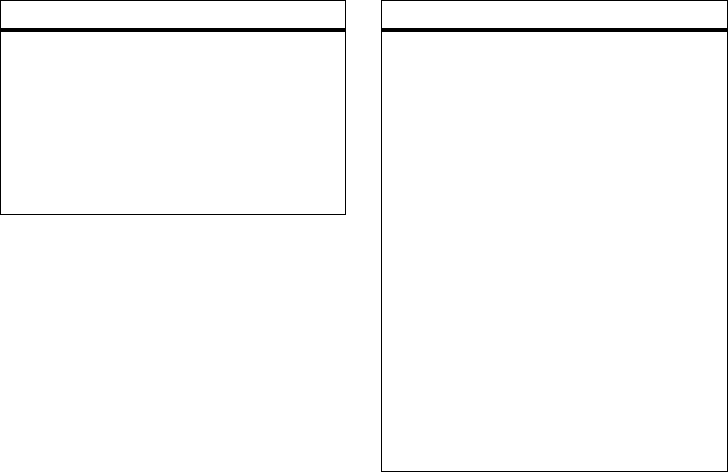
62
e-mail & messages
download complete e-mail messages
Press:
Start
>
Messaging
>(e-mail account). Scroll to the message
and press:
Menu
>
Download Message
.
The complete message is retrieved the next
time you synchronize or connect to your
e-mail server and send and receive e-mail.
features
mark a folder for synchronization
When you synchronize your e-mail account
with your PC, the same Inbox folders that
are in Outlook on your PC are created on
your handset.
Press:
Start
>
Messaging
>(e-mail account), and press:
Menu
>
Folders
>
Menu
>
Show all Folders
,
and press:
Menu
>
Manage Folders
Highlight each folder you want to
synchronize and press
Sync
.
Once all folders have been selected, press
Done
. This opens the
Manage Folders
view, where the marked folders will be
synchronized during the next sync session.
Note:
Only e-mail folders stored on the server are
available for sync.
features

63
e-mail & messages
view status of sent e-mail
Press:
Start
>
Messaging
>(e-mail account)
Menu
>
Folders
>
Outbox.
Messages in the
Outbox
have not been
sent. To send a message, scroll to it and
press:
Menu
>
Send/Receive
.
receive e-mail or text message
Your handset is set up to automatically
check for new messages, your handset will
show
e
when a new message arrives.
Select the Programs tab and select the
e-mail or text message application to open
the inbox.
delete e-mail
From the Inbox or an open e-mail message,
press:
Menu
>
Delete
.
features
manually send and receive e-mail
Press:
Start
>
Messaging
>(e-mail account), and press:
Menu
>
Send/Receive
.
call a phone number in e-mail
Highlight a phone number in a message
and press
N
.
move e-mail to personal folder
After you are done reading the e-mail,
press:
Menu
>
Move
> (folder).
delete a mail account
Press:
Start
>
Messaging
, scroll to the
e-mail account and press:
Menu
>
Delete
.
Note:
You cannot delete your
Text Messages
,
MMS
, or Exchange server e-mail accounts.
features

64
e-mail & messages
instant messaging
To use instant messaging (im), perform the
following:
1
Press:
Start
>
im
2
Select the IM community you want
3
Enter your logon information if it does not appear.
4
Press:
SignIn
/
SignOn
. You will see the status
of the groups and individuals you have designated
in your IM community.
•
To
start
a conversation, highlight the other
person, press
Write
, enter text, and
press
s
.
•
To
switch
to other conversations, press the
navigation key
S
left or right.
•
To
return
to the previous screen, press
Back
.
To return to a conversation, select
Conversations
, select the desired
conversation, then press the center key
s
.
When you are
in a conversation
, press
Menu
to enter pre-stored text messages as
well as icons, or to end the conversation.
When you are
signed in
but not in a
conversation, press
Menu
to manage your
contacts or groups, change your status, or
sign out. To access other communities, press
the navigation key
S
left or right. To store
your logon information, press
Menu
>
Settings
>
Community Settings
, enter
your logon information for each community,
empty deleted items folder
Press:
Start
>
Messaging
>(e-mail account), press:
Menu
>
Folders
,
scroll to
Deleted items
and press:
Menu
>
Delete All
.
features
65
e-mail & messages
then press:
Menu
>
Save
. To change other
settings, press:
Menu
>
Settings
>
Global Settings
.
Note:
You can also access MSN Messenger by clicking
Start > Windows Live.
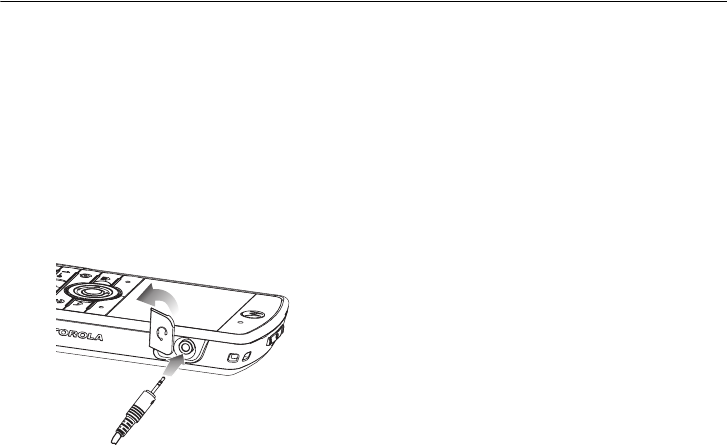
66
connections
connections
PTT & stereo headsets
Use your Audio/PTT jack to plug in an optional
hands-free PTT headset. For purchasing
headsets, refer to “approved accessories” on
page 6.
Warning:
When using a headset, you may not
hear the surrounding sounds. Do not use a
headset where it can endanger your safety.
Bluetooth™ wireless
Your handset supports Bluetooth wireless
pairing (also called linking or bonding). You
can pair your handset with a
Bluetooth headset or with a computer to
exchange and synchronize files.
turn Bluetooth power on or off
If Bluetooth Power is on, your handset can
automatically pair with the handsfree device
you have used before. Turn on the device or
move it near the handset.
To turn Bluetooth on perform the following:
Press:
Start
>
Bluetooth
>
Bluetooth
Manager
>
Settings,
then toggle
Status
to
Bluetooth ON
.
67
connections
The Bluetooth indicator
O
appears in the
home screen.
Note:
To extend battery life, use the previous procedure
to set Bluetooth
Power
to
OFF
when not in use. Your
handset will not pair with devices until you set
Bluetooth
Power
back to
ON
and pair your handset
with the devices again.
pair with a headset or handsfree
device
Before you try to pair your handset with a
device, make sure your handset’s
Bluetooth power is
on
and the device is
on
and
ready
in pairing or bonding mode (see
the device user’s guide). You can pair your
handset with multiple devices, but only use it
with one headset device at a time.
Your handset lists the devices it finds within
range.
1
Press:
Start
>
Bluetooth
>
Bluetooth Manager
>
Hands-free
.
2
Put the device (handsfree headset, stereo headset,
keyboard, etc.) in pairing mode.
3
Press
Add
. The handset prompts you to verify
your device is ready. Press
Search
.
4
Select the device from the list.
5
If prompted, enter the device passkey (such as
0000) and press the
Accept
key.
When the devices are paired, an icon appears
on the home screen in the Bluetooth Task
Tray.
Tip:
For specific information about the Bluetooth device
you are using with your handset, refer to the instructions
that came with it.
68
connections
send objects to another device
You can use Bluetooth pairing to send e-mail,
contacts, tasks, calendar items, audio, ring
tones, pictures, video, and voice notes from
your handset to a computer or other device.
1
Press:
Start
>
Bluetooth
>
BT Send
Object
.
2
Select the object type and object you want to send.
Tip:
To select an item, press the
center key
s
.
3
Press
Send
.
4
Select the name of the device to send the file.
5
To cancel sending an item, press:
Menu
>
Cancel
.
use your handset as a PC remote
You can use Bluetooth wireless and your
handset as a remote control for your
computer. For example, want to watch a video
on your computer and use your handset as a
remote control? Use PC Remote to control
when the video plays, stops, or pauses.
1
On your computer, turn Bluetooth power on.
2
On your handset, press:
Start
>
Bluetooth
>
BT PC Remote
. When necessary, press
Yes
to turn on Bluetooth power.
3
Press
Add
.
4
On your computer, right-click on the
Bluetooth indicator
O
in the system tray in the
lower right corner of your display. Select
Bluetooth Setup Wizard
.
5
In the wizard, indicate that you know the service
you want to use, and you want to find a
Bluetooth device that provides the service. Select
Next.
6
In the next window, choose Human Interface
Device or PC Remote and select Next.

69
connections
7
In the next window, make sure that
“Show all devices” is chosen in the pull-down
menu. Your computer should find your
“SmartPhone.” Make sure the box “Allow other
Bluetooth devices to see this phone” is checked.
Select your handset, and select Next.
8
If prompted, enter the device passkey (such as
0000) and press the
Accept
key.
When PC Remote is connected, your handset
display shows a key map that tells you what
your keys control on the PC. To determine
which program on your computer to control,
on your handset, press
Menu
and select a
program.
advanced Bluetooth features
features
make handset visible to other device
Allow a Bluetooth device to discover your
handset:
Press:
Start
>
Bluetooth
>
Bluetooth Manager
>
Settings
, and
check
Allow other Bluetooth devices to
see this phone
connect to recognized device
Connect to a recognized handsfree device:
Press:
Start
>
Bluetooth
>
Bluetooth Manager
>
Hands-free
>device name

70
connections
synchronize
You can synchronize the information on your
handset in two ways, over the air (OTA) or
using a cable and your computer.
drop pairing with device
Press:
Start
>
Bluetooth
>
Bluetooth Manager
>
Hands-free
>device name >
Disconnect
send object to device
Send an object to another device:
Press:
Start
>
Bluetooth
>
BT Send
Object
features
edit device properties / change device
name
Edit the properties of a recognized device:
Press:
Start
>
Bluetooth
>
Bluetooth Manager
>
Hands-free
>device name, then press:
Menu
>
Properties
>
Nickname
Tip:
To change the Bluetooth name of your handset,
press:
Start
>
Bluetooth
>
Bluetooth Manager
>
Settings
and enter
the name in
My Bluetooth name
.
features
71
connections
sync over the air
Once you enter your organization, handset
sync’s over the air (OTA) directly with your
company’s wireless network. The network
compares your handset’s contact information,
calendar appointments, messages, and media
files to those on your computer and then
updates to the most recent information.
When update that does not happen, contact
your operator to set up this synchronization.
Note:
When you are out of network coverage, and your
handset tries to sync 3 times without finding a network,
you will receive a notification. For more information,
select
View Status
. Synchronization will resume
when there is network coverage.
sync with a computer
You can use Microsoft®
ActiveSync
version 4.5 or above
, or Windows®
Mobile
Device Center
to synchronize information
between your handset and a computer. In
addition to all the activities performed over the
air, ActiveSync enables to view the content of
your handset on your computer. You can
move files between your computer and
handset, download and install applications
and service your handset.
installing & setting up ActiveSync
To synchronize information on your handset
with a PC, you must use
Windows® Mobile Device Center (on a PC
running Windows Vista) or install
Microsoft ActiveSync (on a PC running
Windows XP™ or earlier).
Note:
Synchronization software is installed on your
handset. Before installing the synchronization software,
on your computer, verify that your computer and
operating system meet the
minimum requirements
72
connections
stated on the CD-ROM sleeve of the synchronization
software or Microsoft Windows® Mobile Web site
(
http://www.microsoft.com/windowsm
obile
). This Web site also lets you download the
latest software
for ActiveSync.
1
Install Microsoft ActiveSync (for Windows® XP™ or
earlier) or Windows Mobile Device Center (for
Windows Vista) on your PC.
2
After setup completes, connect your handset to the
PC. The handset drivers install on your computer
and then the Sync Setup Wizard automatically
starts.
3
Follow the instructions on the screen to complete
the wizard.
The wizard prompts you for the Exchange Server’s
name, your user name, your password, and the
domain name. If you don’t have this information,
contact your operator.
Note:
For information about connections
(Bluetooth™ wireless, VPN, and Web browser), see
page (See page 66).
When you finish the wizard, ActiveSync starts
to synchronize automatically with your
handset.
Note:
Once synchronization completes, you can
disconnect your handset from your PC, and restart your
PC.
sync with a cable connection
Once Microsoft® ActiveSync or Windows®
Mobile Device Center is installed on your PC,
you can connect it to your handset and sync.
1
Turn on the handset.
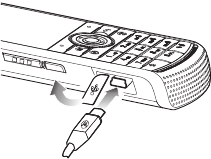
73
connections
2
Connect your
handset to
your PC
using a USB
cable.
Note:
For more
detailed
information, see
“Connecting a mobile device to a PC” in ActiveSync
Help on your PC or the Microsoft Web Site for
ActiveSync.
sync with Bluetooth™ connection
Once Microsoft® ActiveSync or
Windows® Mobile Device Center is installed
on your PC, you can connect it to your
handset and sync with a
Bluetooth connection.
Ensure that the handset and PC are within
close range (within 30 feet). If this is the first
time you have connected to this PC using
Bluetooth wireless, you must complete the
Bluetooth wizard on the handset and set up a
Bluetooth partnership with the PC before
synchronizing.
Note:
In order to use this feature, your PC must be
equipped with Bluetooth wireless or a
Bluetooth PC adaptor accessory.
1
Follow the instructions in ActiveSync Help for
configuring Bluetooth connections on your PC to
support ActiveSync.
2
Turn on the handset.
3
On your handset, verify that Bluetooth wireless is
turned on. Press:
Start
>
Bluetooth
>
Bluetooth Manager
>
Settings
>
Status
>
Bluetooth On
.
4
Press:
Start
>
Settings
>
Connections
>
USB Device Type
.
5
Press:
Start
>
ActiveSync
.
74
connections
6
Select
Menu
>
Connect via Bluetooth
.
7
Select
Sync
.
8
When finished, select
Menu
>
Disconnect Bluetooth
. To conserve battery
power on your handset, turn off Bluetooth power
(see page 73).
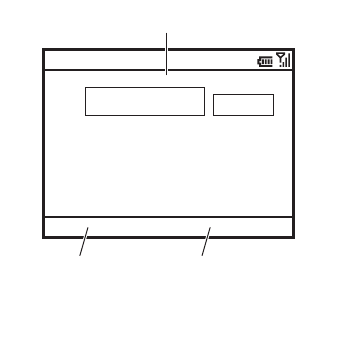
75
connections
web browser
You can use the browser to search and view
the Web.
Find it:
Press:
Start
>
Opera
Note:
Not all Web file formats are supported.
•
To go to a Web page, press:
Action
>
Go to
.
Enter the address and press
OK
.
•
To go to a link in a Web page: use the
navigation key
S
to highlight the link and then
press the center key
s
.
•
To change connection options: press:
Menu
>
Tools
>
Settings
>
Connections
.
•
To show/hide pictures: press:
Menu
>
Display
>
Load Images
.
•
To add a Web address to your Favorites: open
the Web page and press:
Action
>
Bookmark this page
.
Tip:
All finished? When you are done with the browser,
press:
Menu
>
Exit
to close the browser and
conserve battery life.
Action
1:Opera Browser
Browser Links
» Link 1
» Link 2
» Link 3
» Link 4
Search
Menu
Press
Menu
to chang
e
browser settings an
d
other options
.
P
ress
Action
to open
n
avigation options.
Your browser homepage appears.
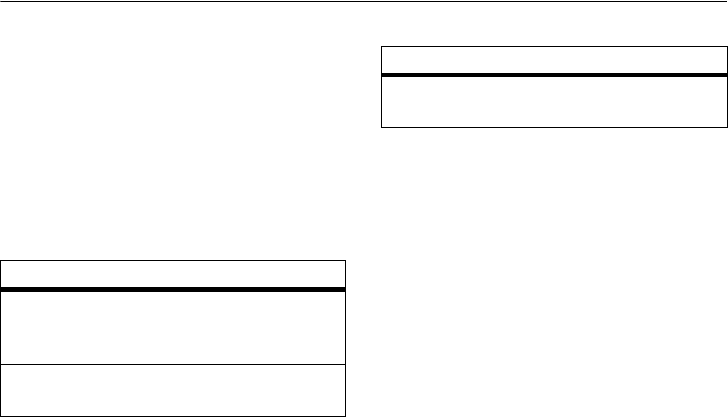
76
entertainment
entertainment
picture options
To view stored pictures in your handset,
perform the following:
1
Press:
Start
>
Pictures & Videos
.
2
In the picture viewfinder press:
Menu
>
Options
3
Open the
Picture Options Menu
. This menu
can include the following options:
play video clip
To view the stored clips in your handset,
press:
Start
>
Pictures & Videos
. Select the
video to view and press
Play
or the
center key
s
.
Tip:
To view videos located in a folder other than the
default video folder, including a storage card, press:
Start
>
Pictures & Videos
, then press:
Menu
>
Folder
, and then select the folder that contains the
stored videos.
option
General
Determine default picture sizes
for e-mail and rotating picture
settings.
Slide
Show
Select default slide show
settings.
Video
Determine audio settings and
time limits for video files.
option
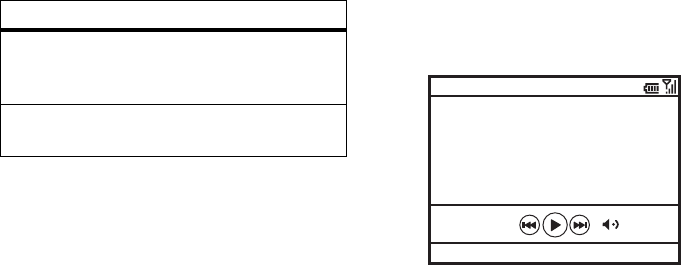
77
entertainment
video options
To view the video options menu in the video
viewfinder perform the following:
Find it:
Press:
Menu
>
Options
to open the video
options menu:
Note:
General
and
Slideshow
options are also
available in this menu, however these settings are
specific to picture files only.
play a video clip
For more video playback and
Windows® Media Player features, see your
MOTOSTART Guide.
Find it:
Press:
Start
>
Pictures & Videos
>video clip >
Play
The video clip plays in the
Windows Media Player
.
Tip:
To play video in full screen mode, press:
Menu
>
Full Screen
. Videos recorded in a low resolution
may not play in full screen mode.
option
Camera
Select default save locations,
video filename prefixes, and
image compression.
Video
Determine audio and time limit
settings for video files.
00:00 70
%
Now Playing
Windows Media
Menu
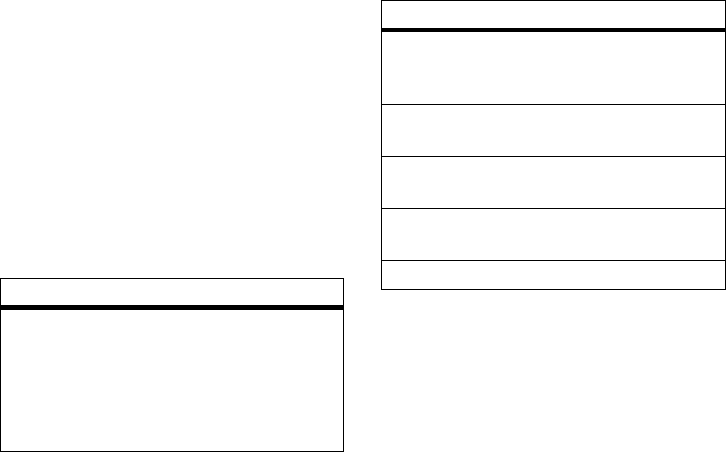
78
entertainment
If a call comes in while watching a video, the
video pauses and a call alert appears. You
can choose to answer the call or ignore it. To
continue watching the movie, select the
Play
button.
video playback options
In the video playback window press:
Menu
>
Options
to open the
Video Playback
Menu
.
This menu can include the following options:
option
Playback
Determines how the time
counter appears, whether to
pause playback while using
another program, and whether
to resume playback after a
phone call.
Video
Options for showing in full
screen and when to scale to fit
window.
Network
Selects default network
settings for streaming media.
Library
Determines if the player starts
on the
Library
view.
Skins
Determine Windows® Media
Player skin theme.
Buttons
Set playback button mapping.
option
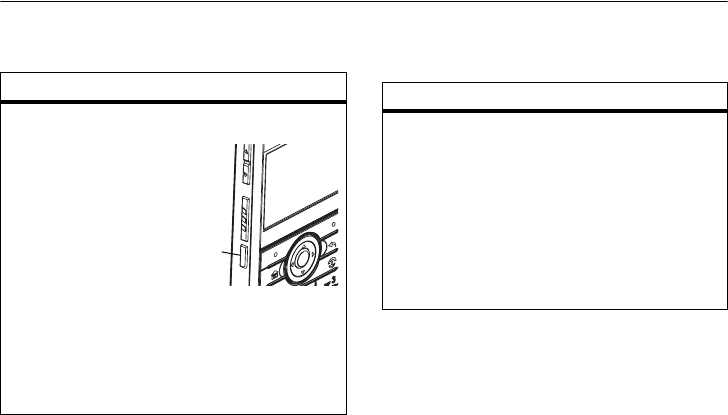
79
other features
other features
quick access key advanced calling
features
programmable key
Set and use
the
programmable
key to access
an application
by a press of a
button. For
example, you can press for viewing your call
history, opening your web browser, etc.
To set the programmable key
Find it:
TBD
P
rogrammable
key
features
call forwarding
Set up or cancel call forwarding:
Press:
Start
>
Settings
>
Phone
>
Call Forwarding
Note:
When you choose
No Reply
, you can set
how many seconds your handset waits before it
forwards a call.
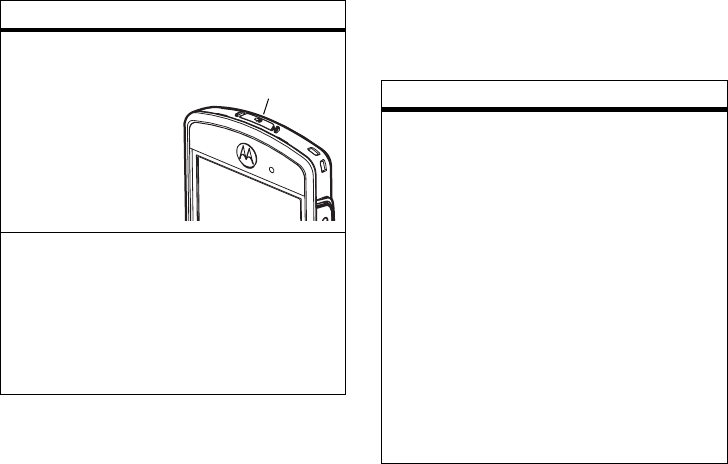
80
other features
contacts
To store and call contacts, see page TBD.
voice dial
To voice dial, press
and hold the
Speaker key
a
.
When prompted, say
“Call,” followed by a
number or contact
name.
call a phone number in a
message
E-mail or text messages can contain phone
numbers that have an underline, like a Web
site hyperlink. To dial one of these numbers,
scroll to it and press
N
.
features
Speaker key
a
features
search for contact
Press:
Start
>
Contacts
, and scroll to
View
By > Name or Company.
Enter the first few letters of the contact's
name or company. The handset searches
through the contact list and shows the
name.
You can also filter your search by Recent
calls, PTT-Capable or Show All users.
To filter your Contacts filter options, perform
the following:
Press:
Start
>
Contacts > Filter By
and
select an option.

other features—contacts
81
edit contact
Press:
Start
>
Contacts
, scroll to a contact,
then press:
Menu
>
Edit Contact
set ringer ID for a contact
To easily identify who is calling you by the
ring tone, you can assign a custom ring tone
to each contact.
Press:
Start
>
Contacts
, scroll to a contact
and press:
Menu
>
Edit
>
Custom Ring
Tone
features
set picture ID for contact
Assign a photo or picture to appear when
you receive a call from an entry:
Press:
Start
>
Contacts
, scroll to a contact,
and press:
Menu
>
Edit
>
Picture
and
Select a picture.
Tip:
Want to remove a picture ID? Press:
Start
>
Contacts
, scroll to a contact, press:
Menu
>
Edit
, then press:
Menu
>
Remove Picture
set category for contact
Press:
Start
>
Contacts
, scroll to a contact
and press:
Menu
>
Edit
>
Categories
set category view
Press:
Start
>
Contacts
and
press:
Menu
>
Filter
features
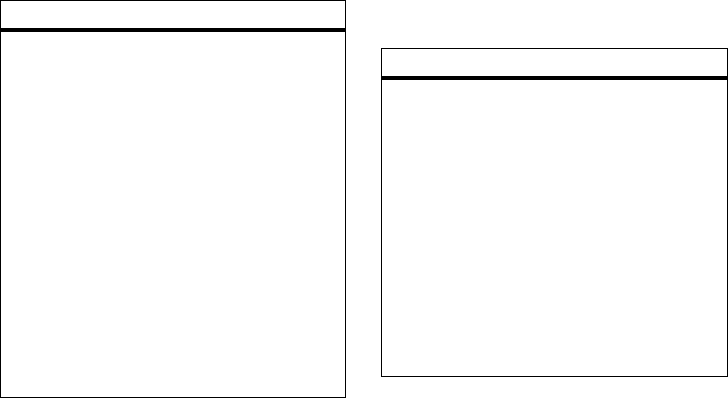
82
other features—personalizing
personalizing
send contact to another device
Use a Bluetooth™ connection to send a
contact to another handset, computer, or
device:
Press:
Start
>
Contacts
, scroll to a contact,
and press:
Menu
>
Send via Bluetooth
When necessary, your handset asks you to
turn on Bluetooth power. Your handset
searches for Bluetooth devices. Select the
one you want and press the center key
s
.
Your handset tells you when the transfer is
complete.
For more about Bluetooth connections, see
page 73.
features
features
language
Set menu language:
Press:
Start
>
Settings
>
Regional
Settings
Note:
You must turn your handset off and on again for
the changes to take effect.
Tip:
While you enter text (such as in a text message),
your handset suggests words. To change the
language for these suggestions, press:
Menu
>
Languages
in the text entry screen to know your
language options.
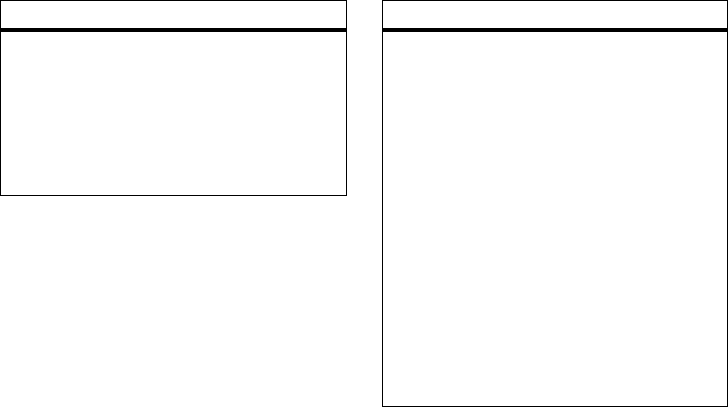
other features—personalizing
83
accessibility
You can set system font size, multipress
time-out, confirmation time-out, and in-call
alerts:
Press:
Start
>
Settings
>
Accessibility
and select an option.
features
ring volume
Press:
Start
>
Settings
>
Profiles
Highlight the desired profile and press:
Menu
>
Edit
Under
Ring Volume
, press: the
navigation key
S
left or right to adjust the
volume for that profile.
Tip:
In the home screen, press and hold the Volume
up/down key on the left side of the handset (See page
33) to show the ring volume, then press the Volume
up/down keys to adjust it.
Tip:
To eliminate the ringer volume instantly when an
incoming call comes in, press the volume up/down
keys.
features
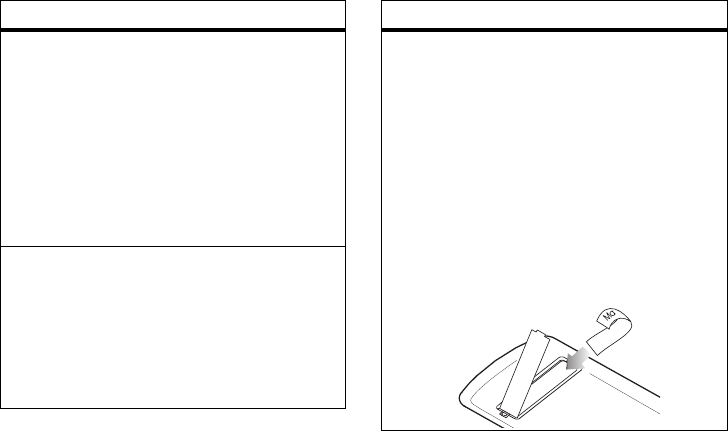
84
other features—personalizing
sounds
To change the default sounds for ring tone,
reminders, new messages, alarm clock, or
keypad controls:
Press:
Start
>
Settings
>
Sounds and
select an option.
Note:
Changes made to the alert settings will have no
effect when using the
Silent
profile.
alarm
Press:
Start
>
Settings
>
Clock & Alarm
>
Alarm
Tip:
Need to change or set the alarm alert style?
Press:
Start
>
Settings
>
Sounds
>
Alarm Clock
.
features
owner information
It is recommended to enter and check your
owner information. It lets someone return
the handset to you if you lose it:
Press:
Start
>
Settings
>
Owner
Information
You can also print a label with your name,
department or handset ID and place it inside
the Label ID Window located on the battery
door.
features
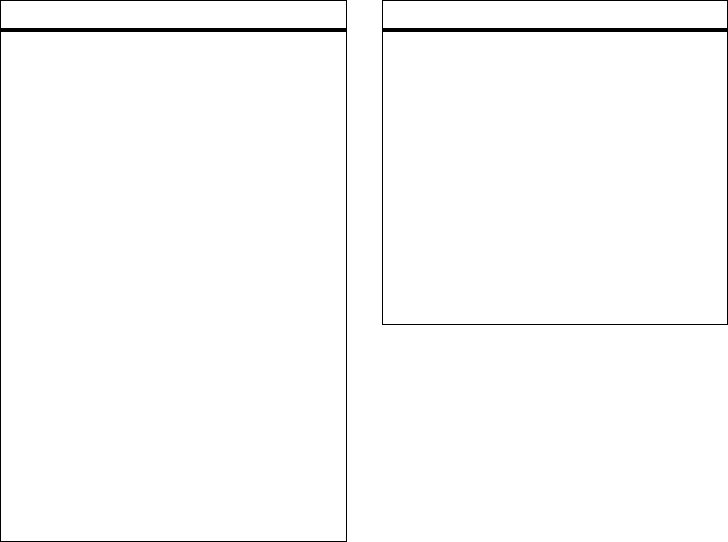
other features—call times
85
call times
Network connection time
is the elapsed time
from the moment you connect to your service
provider's network to the moment you end the
master reset
master reset
A master reset may become necessary
when your handset is jammed and does not
respond to the system.
A master reset is a full restore of a handset
to its original factory settings. It requires
deleting all information on your handset by
reformatting the memory.
Caution:
Used master reset with caution,
as it destroys all data stored on your
handset (files, settings, contacts etc.).
Master reset does not reset the unlock
code, security code, and lifetime timer.
To return your handset to original settings:
Press:
Start
>
System Tools
>
Master Reset
The default master reset code is
000000
(6 zeroes).
features
master clear
Master clear erases all information you
have entered (including contacts and
calendar events) and content you have
downloaded (including photos and sounds)
stored in your handset’s memory.
Note:
After you erase information, the erased
information is unrecoverable.
For master reset, perform the following:
Press:
Start
>
System Tools
>
Master Clear
features
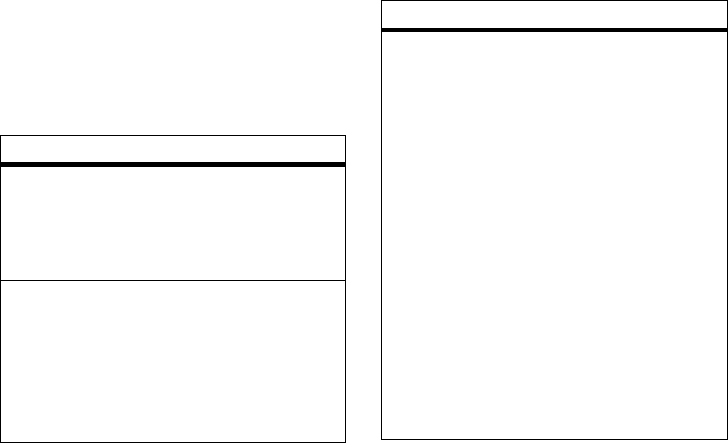
86
other features
call by pressing
O
. This time includes busy
signals and ringing.
The amount of network connection time you
track on your resettable timer may not equal
the amount of time for which you are billed by
your service provider. For billing information,
contact your service provider.
network connections
features
see call timers
Show call timers:
Press:
Start
>
Call History
, then press:
Menu
>
View Timers
reset call timers
To reset all call timers to zero (0), except for
the
Lifetime calls
timer:
Press:
Start
>
Call History
, and
press:
Menu
>
View Timers
, and
press:
Menu
>
Reset Timers
features
create proxy, Virtual Private Network
(VPN), or dial-up network
A Virtual Private Network allows you to
connect securely to your enterprise through
IPsec. This connection requires a policy
definition from your IT department. Your IT
department can send you the policy in a file
or give you the policy to enter manually.
Once you receive the policy file or
information perform the following:
Press:
Start
>
Virtual Private Network
Select a policy to open a connection or
enter a new policy definition:
Press:
Menu
>
New
.
To close the secure connection,
press:
Logoff
.

cycling Information
87
calendar
features
add new calendar event
Press:
Start
>
Calendar
, and press:
Menu
>
New Appointment
Note:
To schedule an all-day event, select the
All day event
check box under
End time
.
All-day events do not occupy blocks of time in the
calendar; instead. All-day events appear in banners
at the top of the calendar.
view calendar event
Press:
Start
>
Calendar
to open the
calendar for today.
•
To see days before or after today, press the
navigation key
S
left or right.
•
To quickly see a specific date, press:
Menu
>
Go to Date
.
•
To see your whole week’s events,
press:
Week
.
Shortcut:
Today’s events appear on your
home screen. To see event details, scroll to
it and press the center key
s
.
features
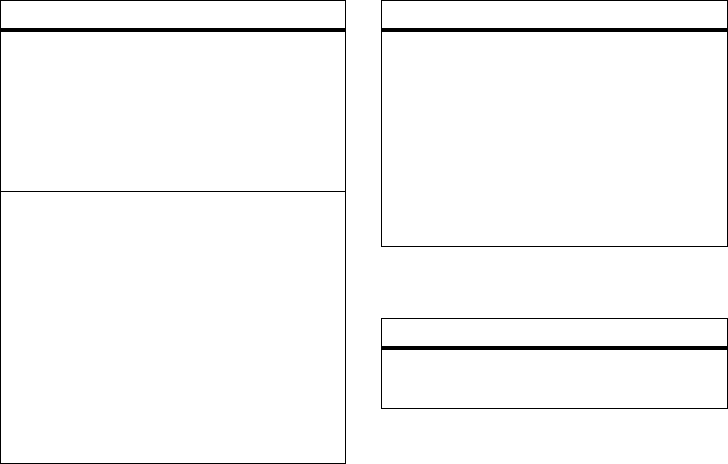
88
cycling Information
calculator
calendar event reminder
The default reminder time for tasks and
calendar items is 15 minutes. To change
this default perform the following:
Press:
Start
>
Calendar
, then press:
Menu
>
Tools
>
Options
>
Set Reminders
send calendar event to another device
Use a Bluetooth™ connection to send a
calendar event to another handset,
computer, or device:
From the calendar item, press:
Menu
>
Send via Bluetooth
.
Select the device to which you want to send
the item.
For more about Bluetooth connections, see
page 73.
features
respond to a meeting request
You can receive and respond to meeting
requests on your handset in a similar
manner as you do in Outlook on your PC.
Press:
Start
>
Messaging
>(e-mail account) > meeting request
Press:
Accept
or
Menu
>
Decline
or
Tentative
features
calculator
Press:
Start
>
Accessories
>
Calculator
features

cycling Information
89
internet security
handset information
features
manage certificates
Enable or disable Internet access
certificates stored on your handset:
Press:
Start
>
Settings
>
Security
>
Certificates
Certificates are used to verify the identity
and security of Web sites when you
download files or share information.
features
software version
To view your handset software version:
Press:
Start
>
Settings
>
Connections
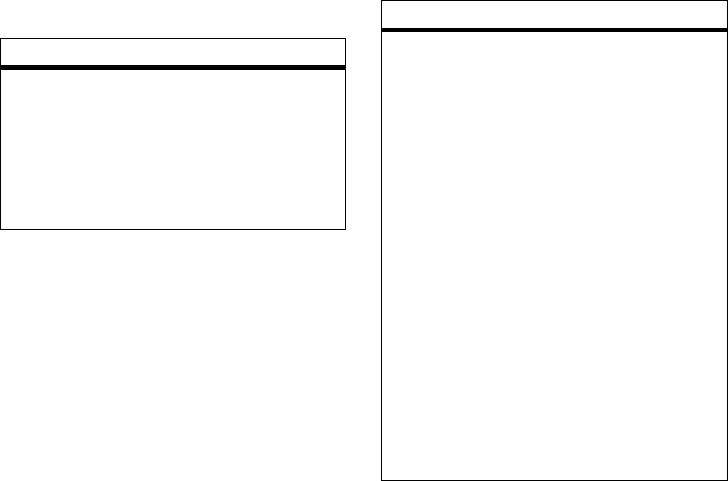
90
cycling Information
handset administration data
features
phone information
Your operator may ask you to access
administration data on your phone for
troubleshooting purposes.
Press:
Start
>
Settings
>
Phone
Information
features
wireless system configuration
Your operator might ask you to access, set
or configure your handset to work with the
wireless system of your organization.
Find it:
Press:
Start
>
Settings
>
Connections
> WSM WiFi Setting.
To configure the wireless settings of your
handset:
Press:
Start
>
Settings
>
Connections >
WSM WiFi Setting > WiFi Settings
Your operator should provide you with
following information:
WSM SSID (Your
network name), Authentication type,
Encryption type, Radius User Name,
Radius Password, and Radius Domain
Name.
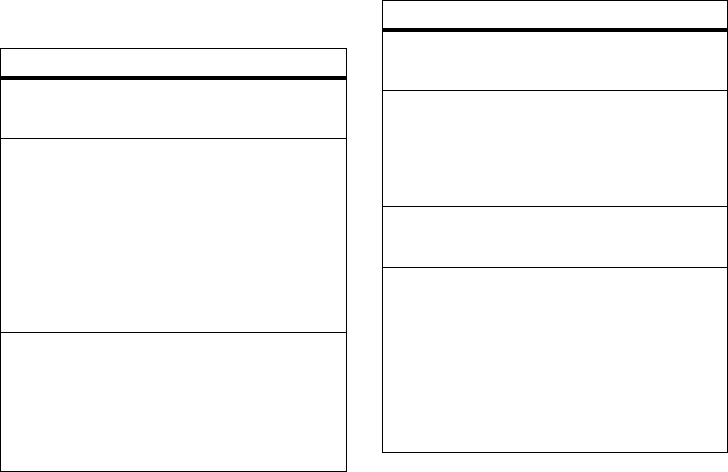
cycling Information
91
fun & games
features
access pictures
Press:
Start
>
Pictures & Videos
access sounds
Manage ring tones and music that you have
downloaded or composed:
Press:
Start
>
Windows Media
For more information about Windows®
Media, see Windows Mobile 6
documentation.
access video clips
Press:
Start
>
Pictures & Videos
For more information about Windows®
Media, see Windows Mobile 6
documentation.
play games on your handset
Press:
Start
>
Games
start Web browser
Press:
Start
>
Opera
For more information about Internet
Explorer Mobile, see page 85.
close Web browser
In the browser, press:
Menu
>
Exit
download objects from Web page
To download a picture, sound, or phone
theme from a Web page: Highlight the file,
press: the center key
s
, then press
Save
.
To download a picture or other object from a
Web page: Highlight the item, press:
Menu
,
and choose an option such as
Save image
.
features

92
cycling Information
manage media files
To view, copy, delete, rename, or move files
and folders on your handset or storage
card:
Press:
Start
>
File Manager
features

cycling Information
93
troubleshooting
Symptom Explanation
The handset does not turn on TBD
The battery does not charge TBD
The handset unresponsive TBD
The handset randomly shuts down TBD
Your calls are disconnected TBD

94
cycling Information
service & repair
Tip:
Software updates are continuously downloaded
during your daily work by your system administration.
These updates are designed to make your handset
performance and security better and update your
handset with new software patches. However, if you
encounter a problem, contact your operator to make
sure you have the latest available software updates.
My operator number is:
My handset repair contact is:

cycling Information
95
Motorola Limited Warranty for the United States and
Canada
Commercial Warranty
MOTOROLA COMMUNICATION PRODUCTS
I. What This Warranty Covers And For How Long
MOTOROLA INC. (“MOTOROLA”) warrants the MOTOROLA
manufactured Communication Products listed below (“Product”)
against defects in material and workmanship under normal use
and service for a period of time from the date of purchase as
scheduled below:
Handset - One (1) Year
Product Accessories - One (1) Year
Motorola, at its option, will at no charge either repair the Product
(with new or reconditioned parts), replace it (with a new or
reconditioned Product), or refund the purchase price of the Product
during the warranty period provided it is returned in accordance
with the terms of this warranty. Replaced parts or boards are
warranted for the balance of the original applicable warranty
period. All replaced parts of Product shall become the property of
MOTOROLA.
This express limited warranty is extended by MOTOROLA to the
original end user purchaser only and is not assignable or
transferable to any other party. This is the complete warranty for
the Product manufactured by MOTOROLA. MOTOROLA assumes
no obligations or liability for additions or modifications to this
warranty unless made in writing and signed by an officer of
MOTOROLA. Unless made in a separate agreement between
MOTOROLA and the original end user purchaser, MOTOROLA does
not warrant the installation, maintenance or service of the Product.
MOTOROLA cannot be responsible in any way for any ancillary
equipment not furnished by MOTOROLA which is attached to or
used in connection with the Product, or for operation of the Product
with any ancillary equipment, and all such equipment is expressly
excluded from this warranty. Because each system which may use
the Product is unique, MOTOROLA disclaims liability for range,
coverage, or operation of the system as a whole under this
warranty.
96
cycling Information
II. General Provisions
This warranty sets forth the full extent of MOTOROLA’s
responsibilities regarding the Product. Repair, replacement or
refund of the purchase price, at MOTOROLA’s option, is the
exclusive remedy. THIS WARRANTY IS GIVEN IN LIEU OF ALL
OTHER EXPRESS WARRANTIES. IMPLIED WARRANTIES,
INCLUDING WITHOUT LIMITATION, IMPLIED WARRANTIES OF
MERCHANTABILITY AND FITNESS FOR A PARTICULAR PURPOSE,
ARE LIMITED TO THE DURATION OF THIS LIMITED WARRANTY. IN
NO EVENT SHALL MOTOROLA BE LIABLE FOR DAMAGES IN
EXCESS OF THE PURCHASE PRICE OF THE PRODUCT, FOR ANY
LOSS OF USE, LOSS OF TIME, INCONVENIENCE, COMMERCIAL
LOSS, LOST PROFITS OR SAVINGS OR OTHER INCIDENTAL,
SPECIAL OR CONSEQUENTIAL DAMAGES ARISING OUT OF THE
USE OR INABILITY TO USE SUCH PRODUCT, TO THE FULL EXTENT
SUCH MAY BE DISCLAIMED BY LAW.
III. State Law Rights
SOME STATES DO NOT ALLOW THE EXCLUSION OR LIMITATION
OF INCIDENTAL OR CONSEQUENTIAL DAMAGES OR LIMITATION
ON HOW LONG AN IMPLIED WARRANTY LASTS, SO THE ABOVE
LIMITATION OR EXCLUSIONS MAY NOT APPLY.
This warranty gives specific legal rights, and there may be other
rights which may vary from state to state.
IV. How To Get Warranty Service
You must provide proof of purchase (bearing the date of purchase
and Product item serial number) in order to receive warranty
service and, also, deliver or send the Product item, transportation
and insurance prepaid, to an authorized warranty service location.
Warranty service will be provided by Motorola through one of its
authorized warranty service locations. If you first contact the
company which sold you the Product, it can facilitate your
obtaining warranty service. You can also call Motorola at
1-888-567-7347 US/Canada.
V. What This Warranty Does Not Cover
A. Defects or damage resulting from use of the Product in other
than its normal and customary manner.
B. Defects or damage from misuse, accident, water, or neglect.
C. Defects or damage from improper testing, operation,
maintenance, installation, alteration, modification, or adjustment.
D. Breakage or damage to antennas unless caused directly by
defects in material workmanship.
E. A Product subjected to unauthorized Product modifications,
disassemblies or repairs (including, without limitation, the addition
to the Product of non-Motorola supplied equipment) which
adversely affect performance of the Product or interfere with
Motorola's normal warranty inspection and testing of the Product
to verify any warranty claim.
F. Product which has had the serial number removed or made
illegible.
cycling Information
97
G. Rechargeable batteries if:
any of the seals on the battery enclosure of cells are broken or
show evidence of tampering.
the damage or defect is caused by charging or using the battery in
equipment or service other than the Product for which it is
specified.
H. Freight costs to the repair depot.
I. A Product which, due to illegal or unauthorized alteration of the
software/firmware in the Product, does not function in accordance
with MOTOROLA’s published specifications or the FCC type
acceptance labeling in effect for the Product at the time the
Product was initially distributed from MOTOROLA.
J. Scratches or other cosmetic damage to Product surfaces that
does not affect the operation of the Product.
K. Normal and customary wear and tear.
VI. Patent And Software Provisions
MOTOROLA will defend, at its own expense, any suit brought
against the end user purchaser to the extent that it is based on a
claim that the Product or parts infringe a United States patent, and
MOTOROLA will pay those costs and damages finally awarded
against the end user purchaser in any such suit which are
attributable to any such claim, but such defense and payments are
conditioned on the following:
A. that MOTOROLA will be notified promptly in writing by such
purchaser of any notice of such claim;
B. that MOTOROLA will have sole control of the defense of such
suit and all negotiations for its settlement or compromise; and
C. should the Product or parts become, or in MOTOROLA’s opinion
be likely to become, the subject of a claim of infringement of a
United States patent, that such purchaser will permit MOTOROLA,
at its option and expense, either to procure for such purchaser the
right to continue using the Product or parts or to replace or modify
the same so that it becomes noninfringing or to grant such
purchaser a credit for the Product or parts as depreciated and
accept its return. The depreciation will be an equal amount per
year over the lifetime of the Product or parts as established by
MOTOROLA.
MOTOROLA will have no liability with respect to any claim of
patent infringement which is based upon the combination of the
Product or parts furnished hereunder with software, apparatus or
devices not furnished by MOTOROLA, nor will MOTOROLA have
any liability for the use of ancillary equipment or software not
furnished by MOTOROLA which is attached to or used in
connection with the Product. The foregoing states the entire
liability of MOTOROLA with respect to infringement of patents by
the Product or any parts thereof.
Laws in the United States and other countries preserve for
MOTOROLA certain exclusive rights for copyrighted MOTOROLA
software such as the exclusive rights to reproduce in copies and
distribute copies of such Motorola software. MOTOROLA software
98
service & repair
may be used in only the Product in which
the software was originally embodied and
such software in such Product may not be
replaced, copied, distributed, modified in
any way, or used to produce any
derivative thereof. No other use including,
without limitation, alteration,
modification, reproduction, distribution, or
reverse engineering of such MOTOROLA
software or exercise of rights in such
MOTOROLA software is permitted. No
license is granted by implication, estoppel
or otherwise under MOTOROLA patent
rights or copyrights.
VII. Governing Law
This Warranty is governed by the laws of
the State of Illinois, USA.
EPS – 48759 – O

service & repair
99
Microsoft End User License Agreement
Microsoft License
You have acquired a device ("DEVICE")
that includes software licensed by
Motorola, Inc. ("Motorola") from one or
more third-party licensors ("Licensor"), for
use in connection with wireless network
services provided under separate
agreement between you and a wireless
telecommunications provider ("Mobile
Operator"). Those installed software
products provided by Licensor, as well as
associated media, printed materials, and
"online" or electronic documentation
("SOFTWARE") are protected by
international intellectual property laws
and treaties. SOFTWARE includes
software already installed on the DEVICE
("DEVICE Software") and Licensor
software contained on any CD-ROM disk
accompanying the DEVICE ("Desktop
Software").
The SOFTWARE is licensed, not sold. All
rights reserved.
IF YOU DO NOT AGREE TO THIS END
USER LICENSE AGREEMENT ("EULA"), DO
NOT USE THE DEVICE OR COPY THE
SOFTWARE. INSTEAD, PROMPTLY
CONTACT MOTOROLA FOR
INSTRUCTIONS ON RETURN OF THE
UNUSED DEVICE(S) FOR A REFUND. ANY
USE OF THE SOFTWARE, INCLUDING BUT
NOT LIMITED TO USE ON THE DEVICE,
WILL CONSTITUTE YOUR AGREEMENT
TO THIS EULA (OR RATIFICATION OF ANY
PREVIOUS CONSENT).
1. GRANT OF SOFTWARE LICENSE. This
EULA grants you the following license:
1.1. DEVICE Software. You may use the
DEVICE Software as installed on the
DEVICE (including as installed on
removable media installed in the DEVICE).
All or certain portions of the DEVICE
Software may be inoperable if a proper
account is not established or maintained
with an appropriate Mobile Operator, or if
the Mobile Operator's network facilities
are not operating or configured to operate
with the DEVICE software.
1.2. Desktop Software. If Desktop
Software is included with your DEVICE,
you may install and use the Desktop
Software on one (1) or more computers to
exchange information with one (1) or more
computing devices that contain a
compatible version of the DEVICE
Software. For other software
component(s) contained in the Desktop
Software, you may install and use such
components only in accordance with the
terms of the printed or online end user
license agreement(s) provided with such
component(s). In the absence of an end
user license agreement for particular
component(s) of the Desktop Software,
you may install and use only one (1) copy
of such component(s) on the DEVICE or a
single computer with which you use the
DEVICE.
1.3. Back-up Copy. If Motorola has not
included a back-up copy of the DEVICE
Software with the DEVICE, you may make
a single back-up copy of the DEVICE
100
service & repair
Software. You may use the back-up copy
solely for archival purposes.
1.4. Microsoft Windows® 2003. If
Microsoft Outlook® 2002 is included with
your Device, the following terms apply to
your use of Microsoft Outlook® 2002: (i)
regardless of the information contained in
"Software Installation and Use" section of
the online EULA you may install one (1)
copy of Microsoft Outlook® 2002 on one
(1) computer to use, exchange data, share
data, access and interact with the
DEVICE, and (ii) the EULA for Microsoft
Outlook® 2002 is between Motorola and
the end user - not between the PC
manufacturer and end user.
2. Speech/Handwriting Recognition. If the
Software includes speech and or
handwriting recognition component(s),
you should understand that speech and
handwriting recognition are inherently
statistical processes; that recognition
errors are inherent in the processes; that
it is your responsibility to provide for
handling such errors and to monitor the
recognition processes and correct any
errors. Motorola, its affiliates,
subsidiaries, or suppliers shall not be
liable for any damages arising out of
errors in the speech and handwriting
recognition processes.
3. Limitations on Reverse Engineering,
Decompilation and Disassembly. You may
not reverse engineer, decompile, or
disassemble the SOFTWARE, except and
only to the extent that such activity is
expressly permitted by applicable law
notwithstanding this limitation.
4. Single DEVICE. The Device Software is
licensed with the DEVICE as a single
integrated product. The DEVICE Software
may only be used as part of the DEVICE,
notwithstanding any installation of the
DEVICE Software on removable media.
5. Single EULA. The package for the
DEVICE may contain multiple versions of
this EULA, such as multiple translations
and/or multiple media versions (e.g., in
the user documentation and in the
software). Even if you receive multiple
versions of the EULA, you are licensed to
use only one (1) copy of the DEVICE
Software.
6. Rental. You may not rent or lease the
SOFTWARE.
7. Software Transfer. You may not
permanently transfer any of your rights
under this EULA with regard to the
DEVICE Software or Desktop Software,
except as permitted by the applicable
Mobile Operator. In the event that the
Mobile Operator permits such transfer,
you may permanently transfer all of your
rights under this EULA only as part of a
sale or transfer of the DEVICE, provided
you retain no copies, you transfer all of
the SOFTWARE (including all component
parts, the media and printed materials,
any upgrades or backup copies, this EULA
and, if applicable, the Certificate(s) of
Authenticity), and the recipient agrees to
the terms of this EULA. If the Software is
an upgrade, any transfer must include all
prior versions of the SOFTWARE.
8. Termination. Without prejudice to any
other rights, Motorola, Licensor and their
affiliates and subsidiaries may terminate
this EULA if you fail to comply with the
terms and conditions of this EULA. In such
event, you must destroy all copies of the
SOFTWARE and all of its component parts.
9. Security Updates. The SOFTWARE may
include digital rights management
service & repair
101
technology. If SOFTWARE does contain
digital rights management technology,
content providers are using the digital
rights management technology ("Licensor
DRM") contained in the SOFTWARE to
protect the integrity of their content
("Secure Content") so that their
intellectual property, including copyright,
in such content is not misappropriated.
Owners of such Secure Content ("Secure
Content Owners") may, from time to time,
request Licensor, or its subsidiaries or
affiliates to provide security related
updates to the Licensor DRM components
of the SOFTWARE ("Security Updates")
that may affect your ability to copy,
display and/or play Secure Content
through Licensor software or third party
applications that utilize Licesnor DRM.
You therefore agree that, if you elect to
download a license from the Internet
which enables your use of Secure
Content, Licensor, its subsidiaries or
affiliates may, in conjunction with such
license, also download onto your DEVICE
such Security Updates that a Secure
Content Owner has requested that
Licensor, its subsidiaries or affiliates, to
distribute. Licensor, its subsidiaries or
affiliates will not retrieve any personally
identifiable information, or any other
information, from your DEVICE by
downloading such Security Updates.
10. Consent to Use of Data. You agree
that Licensor, its subsidiaries and
affiliates may collect and use technical
information gathered in any manner as
part of product support services related to
the SOFTWARE.. Licensor, its subsidiaries
and affiliates may use this information
solely to improve their products or to
provide customized services or
technologies to you. Licensor, its
affiliates and subsidiaries may disclose
this information to others, but not in a
form that personally identifies you.
11. Internet Gaming/Update Features. If
the SOFTWARE provides, and you choose
to utilize, the Internet gaming or update
features within the SOFTWARE, it is
necessary to use certain computer
system, hardware, and software
information to implement the features. By
using these features, you explicitly
authorize Licensor, its subsidiaries and
affiliates, and/or their designated agent
to use this information solely to improve
their products or to provide customized
services or technologies to you. Licensor,
its subsidiaries and affiliates may
disclose this information to others, but not
in a form that personally identifies you.
12. Internet-Based Services Components.
The SOFTWARE may contain components
that enable and facilitate the use of
certain Internet-based services. You
acknowledge and agree that Licensor, its
affiliates and subsidiaries may
automatically check the version of the
SOFTWARE and/or its components that
you are utilizing and my provide upgrades
or supplements to the SOFTWARE that
may be automatically downloaded to your
Device.
13. Links to Third Party Sites. The
SOFTWARE may provide you with the
ability to link to third party sites through
the use of the SOFTWARE. The third party
sites are NOT under the control of
Motorola, Licensor, or their affiliates or
subsidiaries. Neither Motorola, Licensor,
nor their affiliates or subsidiaries are
responsible for (i) the contents of any third
party sites, any links contained in third
sites, or any changes or updates to third
102
service & repair
party sites, or (ii) webcasting or any other
form of transmission received from any
third party sites. If the SOFTWARE
provides links to third party sites, those
links are provided to you only as a
convenience, and the inclusion of any link
does not imply an endorsement of the
third party site by Motorola, Licensor, or
their affiliates or subsidiaries.
14. Additional Software/Services. The
SOFTWARE may permit Motorola,
Licensor, their affiliates or subsidiaries to
provide or make available to you
SOFTWARE updates, supplements, add-on
components, or Internet-based services
components of the SOFTWARE after the
date you obtain your initial copy of the
SOFTWARE ("Supplemental
Components").
14.1. If Motorola, or its subsidiaries or
affiliates, provides or makes available to
you Supplemental Components and no
other EULA terms are provided along with
the Supplemental Components, then the
terms of this EULA shall apply.
14.2. If Licensor, or its affiliates or
subsidiaries, make available
Supplemental Components, and no other
EULA terms are provided, then the terms
of this EULA shall apply, except that the
Licensor, or its affiliates or subsidiaries
providing the Supplemental Component(s)
shall be the licensor of the Supplemental
Component(s).
14.3. Motorola, Licensor, and their
affiliates and subsidiaries reserve the
right to discontinue any Internet-based
services provided to you or made
available to you through the use of the
SOFTWARE.
15. UPGRADES AND RECOVERY MEDIA.
15.1. DEVICE Software. If the DEVICE
Software is provided by Motorola, its
subsidiaries or affiliates, separate from
the DEVICE on media such as a ROM chip,
CD ROM disk(s) or via web download or
other means, and is labeled "For Upgrade
Purposes Only" or "For Recovery Purposes
Only", you may install one copy of such
DEVICE Software on the DEVICE as a
replacement copy for the existing DEVICE
Software and use it in accordance with
the Grant of Software License section of
this EULA.
15.2. Desktop Software. If any Desktop
Software component(s) is provided by
Motorola, its subsidiaries or affiliates,
separate from the DEVICE on CD ROM
disk(s) or via web download or other
means, and labeled "For Upgrade
Purposes Only" or "For Recovery Purposes
Only", you may (i) install and use one copy
of such component(s) on the computer(s)
you use to exchange data with the DEVICE
as a replacement copy for the existing
Desktop Software component(s).
16. COPYRIGHT. All title and intellectual
property rights in and to the SOFTWARE
(including but not limited to any images,
photographs, animations, video, audio,
music, text and "applets", incorporated
into the SOFTWARE), the accompanying
printed materials, and any copies of the
SOFTWARE, are owned by Motorola,
Licensor, and/or their affiliates,
subsidiaries, or suppliers. You may not
copy the printed materials accompanying
the SOFTWARE. All title and intellectual
property rights in and to the content
which may be accessed through use of
the SOFTWARE is the property of the
respective content owner and may be
103
service & repair
protected by applicable copyright or other intellectual property
laws and treaties. This EULA grants you no rights to use such
content. All rights not specifically granted under this EULA are
reserved by Motorola, Licensor, their affiliates, subsidiaries, and
suppliers.
17. EXPORT RESTRICTIONS. You acknowledge that SOFTWARE is
subject to U.S. export jurisdiction. You agree to comply with all
applicable international and national laws that apply to the
SOFTWARE, including the U.S. Export Administration Regulations,
as well as end-user, end-use and destination restrictions issued by
U.S. and other governments.
18. PRODUCT SUPPORT. Product support for the SOFTWARE is NOT
provided by Licensor, its parent corporation, or their affiliates or
subsidiaries.
19. NO LIABILITY FOR CERTAIN DAMAGES. EXCEPT AS
PROHIBITED BY LAW, MOTOROLA, LICENSOR, AND THEIR
AFFILIATES AND SUBSIDIARIES, SHALL HAVE NO LIABILITY FOR
ANY INDIRECT, SPECIAL, CONSEQUENTIAL OR INCIDENTAL
DAMAGES ARISING FROM OR IN CONNECTION WITH THE USE
OR PERFORMANCE OF THE SOFTWARE. THIS LIMITATION SHALL
APPLY EVEN IF ANY REMEDY FAILS OF ITS ESSENTIAL PURPOSE.
20. FOR APPLICABLE LIMITED WARRANTIES AND SPECIAL
PROVISIONS PERTAINING TO YOUR PARTICULAR JURISDICTION,
PLEASE REFER TO YOUR WARRANTY BOOKLET INCLUDED WITH
THIS PACKAGE OR PROVIDED WITH THE SOFTWARE PRINTED
MATERIALS.

104
index
index
A
access 85
accessibility 78
accessories 19, 81
accessory connector port 2, 3
ActiveSync 61
alarm 79
alert
set 34
turn off 31, 39, 68
animation 84
answer a call 23, 37
attachments 51
auto-lock
phone 32
B
background 36
backlight 37
battery 20
extending battery life 21
battery indicator 28
battery life, extending 37, 56
Bluetooth connection 77, 83
Bluetooth indicator 28
Bluetooth remote 58
Bluetooth wireless 56
bonding (See Bluetooth wireless)
browser 85
disconnect 85
C
calculator 83
105
index
calendar 82, 83
call
answer 23, 37
end 23
forwarding 75
make 23
call timers 80
caller ID 40, 77
camera 69, 71
cancel message 48
car kit 81
center key 2, 3
certificate management 84
codes 32
conference calls 43
contacts 41, 76
copy files 57
D
date, 35
delete program 38
dial a phone number 23
dialed calls 39
display 26, 37
download e-mail messages 52
download message objects 52
E
e-mail 45, 49, 50
attachment 51
signature 50
emergency number 41
end a call 23
end key 2, 3, 23
enter
numbers 30
text 30
F
file manager 85
filter 40
forward 51
106
index
forward calls 75
G
games 85
global access look up 48
H
handsfree 81
speakerphone 32
headset 81
headset jack 2, 3
home screen 26, 36
hyperlink
phone number 76
I
IM 54
Incoming Call message 41
instant messaging 54
international access code 41
ISP 49
L
language 78
linking (See Bluetooth wireless)
lock
phone 32
Low Battery message 28
lowercase 30
M
make a call 23
make call 76
manage files 85
master clear 80
master reset 79
media player 79
menu icons 26
menu indicator 26
menu key 2, 3
menu shortcuts 42
107
index
message 49, 50, 51
message indicator 27, 28
message reminders 79
messages 45, 49
e-mail 45
text 45
missed call 40
Missed Calls message 40
modem 63
multimedia message 45, 50, 51
music 84
N
navigation key 2, 3
network settings 81
networking 63
number. See phone number
numbers 30
numeric entry mode 30
O
object exchange 57
open
program 18
open program 18
optional accessory 19
optional feature 19
over the air (OTA) 60
owner information 79, 80
P
pairing (See Bluetooth wireless)
PC remote 58
personalize 78
phone 32
phone number 24
photo 69, 84
picture 84
picture ID 41, 77
power key 2, 3, 22
priority 48
108
index
profile 34
program
open 18
R
received calls 39
recent calls 39
redial 40
reminders 79
remote control 58
remove program 38
reply 51
return a call 40
ring style indicator 28
ring style, setting 34
ring tone 84
ringer ID 41, 76
ringer volume 78
roam indicator 28
S
safety information 9
security
lock 32
send and receive messages 45
send key 2, 3, 23
shortcuts 42
side scroll keys 2, 3
side select key 2, 3
signal strength indicator 28
signature 50
soft keys 2, 3, 26
sounds 79, 84
speakerphone 81
speed dial 41
Start menu 18
store your number 24
symbol entry mode 30
sync (cable) 62
synch (Bluetooth) 63
synchronize 60
109
index
synchronizing with computer 61
T
task manager 38
telephone number. See phone number
text 30
text entry 29
text message 49, 50, 51
third party applications 37
three way calling 43
time, setting 35
timers 39, 80
TTY calls 75
turn on/off 22
U
unlock
phone 32
unlock code 32
uppercase 30
V
video 85
video clip 71
video clips 85
voice key 2, 3
voicemail 43
voicemail message indicator 43
volume 31, 78
Volume up/doun keys 2, 3
W
wallpaper 36
warranty 88
web 85
phone number 76
web browser 85
web page 85
Y
your phone number 24
110
index
U.S. patent Re. 34,976